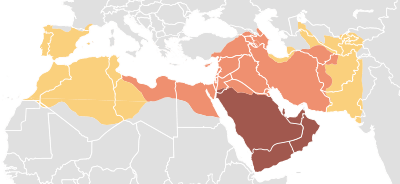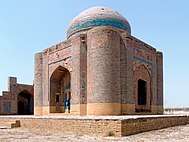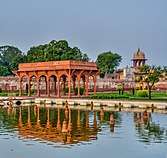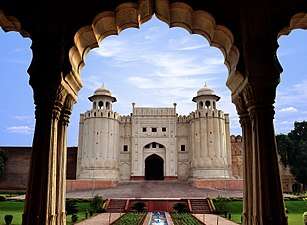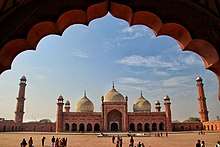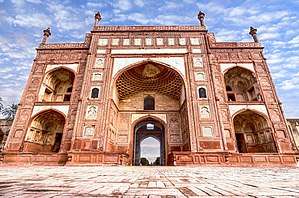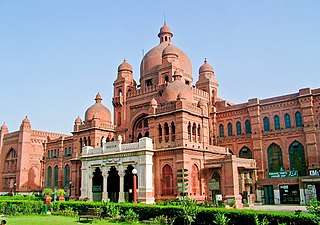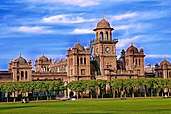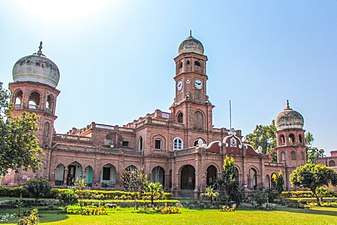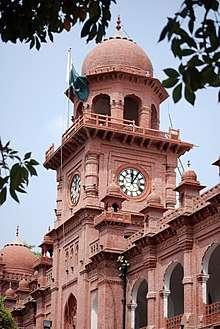History of Pakistan
The history of Pakistan encompasses the region of the Indus Valley,[1][2][3][4] which spans the western expanse of the Indian subcontinent and the eastern Iranian plateau.[5] The region served both as the fertile ground of a major civilisation and as the gateway of South Asia to Central Asia and the Near East.[6][7]
Part of a series on the |
|---|
| History of Pakistan |
 |
| Timeline |
|
Ancient
|
|
Classical
|
|
Medieval
|
|
Early modern
|
|
Modern
|
|
History of provinces |
|
| Part of a series on the |
| Culture of Pakistan |
|---|
 |
| Traditions |
|
Mythology and folklore
|
| Cuisine |
|
Festivals |
|
Art
|
|
Literature |
|
Music and performing arts
|
|
Media
|
| Sport |
|
Monuments |
|
| Outline of South Asian history | ||||||||||||||||||||||||||||||||||||||||||||
|---|---|---|---|---|---|---|---|---|---|---|---|---|---|---|---|---|---|---|---|---|---|---|---|---|---|---|---|---|---|---|---|---|---|---|---|---|---|---|---|---|---|---|---|---|
_without_national_boundaries.svg.png) | ||||||||||||||||||||||||||||||||||||||||||||
|
Palaeolithic (2,500,000–250,000 BC) |
||||||||||||||||||||||||||||||||||||||||||||
|
Neolithic (10,800–3300 BC)
|
||||||||||||||||||||||||||||||||||||||||||||
|
Chalcolithic (3500–1500 BC)
|
||||||||||||||||||||||||||||||||||||||||||||
|
Bronze Age (3300–1300 BC)
|
||||||||||||||||||||||||||||||||||||||||||||
|
Iron Age (1500–200 BC)
|
||||||||||||||||||||||||||||||||||||||||||||
|
Middle Kingdoms (230 BC – AD 1206) |
||||||||||||||||||||||||||||||||||||||||||||
|
Late medieval period (1206–1526)
|
||||||||||||||||||||||||||||||||||||||||||||
|
Early modern period (1526–1858)
|
||||||||||||||||||||||||||||||||||||||||||||
|
Colonial states (1510–1961)
|
||||||||||||||||||||||||||||||||||||||||||||
|
Periods of Sri Lanka
|
||||||||||||||||||||||||||||||||||||||||||||
|
Specialised histories |
||||||||||||||||||||||||||||||||||||||||||||
Situated on the first coastal migration route of Homo sapiens out of Africa, the region was inhabited early by modern humans.[8][9] The 9,000-year history of village life in South Asia traces back to the Neolithic (7000–4300 BCE) site of Mehrgarh in Pakistan,[10][11][12] and the 5,000-year history of urban life in South Asia to the various sites of the Indus Valley Civilization, including Mohenjo Daro and Harappa.[13][14]
The ensuing millennia saw the region of present-day Pakistan absorb many influences—represented among others in the ancient Buddhist sites of Taxila, and Takht-i-Bahi, the 14th-century Islamic-Sindhi monuments of Thatta, and the 17th-century Mughal monuments of Lahore. In the first half of the 19th century, the region was appropriated by the East India Company, followed, after 1857, by 90 years of direct British rule, and ending with the creation of Pakistan in 1947, through the efforts, among others, of its future national poet Allama Iqbal and its founder, Muhammad Ali Jinnah. Since then, the country has experienced both civilian-democratic and military rule, resulting in periods of significant economic and military growth as well those of instability; significant during the latter, was the Bangladesh Liberation War, in 1971, of East Pakistan as the new nation of Bangladesh.
History by region
- History of Azad Jammu & Kashmir
- History of Balochistan
- History of East Pakistan
- History of Gilgit-Baltistan
- History of Islamabad Capital Territory
- History of Khyber Pakhtunkhwa
- History of Punjab
- History of Sindh
Prehistory
Paleolithic period
Riwat is a Paleolithic site in upper Punjab. Riwat Site 55, shows a later occupation dated to around 45,000 years ago. The Soanian is archaeological culture of the Lower Paleolithic, Acheulean. It is named after the Soan Valley in the Sivalik Hills, near modern-day Islamabad/Rawalpindi. In Adiyala and Khasala, about 16 kilometres (9.9 mi) from Rawalpindi, on the bend of the Soan River hundreds of edged pebble tools were discovered. No human skeletons of this age have yet been found.
Neolithic period
Mehrgarh is an important neolithic site discovered in 1974, which shows early evidence of farming and herding,[15] and dentistry.[16] The site dates back to 7000–5500 BCE and is located on the Kachi Plain of Balochistan. The residents of Mehrgarh lived in mud brick houses, stored grain in granaries, fashioned tools with copper ore, cultivated barley, wheat, jujubes and dates, and herded sheep, goats and cattle. As the civilization progressed (5500–2600 BCE) residents began to engage in crafts, including flint knapping, tanning, bead production, and metalworking. The site was occupied continuously until 2600 BCE,[17] when climatic changes began to occur. Between 2600 and 2000 BCE, region became more arid and Mehrgarh was abandoned in favor of the Indus Valley,[18] where a new civilization was in the early stages of development.[19]
Indus Valley Civilisation
The Bronze Age in the Indus Valley began around 3300 BCE with the Indus Valley Civilization.[20] Along with Ancient Egypt and Mesopotamia, it was one of three early civilizations of the Old World, and of the three the most widespread,[21] covering an area of 1.25 million km2.[22] It flourished in the basins of the Indus River, in what is today the Pakistani provinces of Sindh, Punjab and Balochistan, and along a system of perennial, mostly monsoon-fed, rivers that once coursed in the vicinity of the seasonal Ghaggar-Hakra River in parts of north-west India.[23] At its peak, the civilization hosted a population of approximately 5 million spread across hundreds of settlements extending as far as the Arabian Sea to present-day southern and eastern Afghanistan, and the Himalayas.[24] Inhabitants of the ancient Indus river valley, the Harappans, developed new techniques in metallurgy and handicraft (carneol products, seal carving), and produced copper, bronze, lead, and tin.
The Mature Indus civilisation flourished from about 2600 to 1900 BCE, marking the beginning of urban civilisation in the Indus Valley. The civilisation included urban centres such as Harappa, Ganeriwala and Mohenjo-daro as well as an offshoot called the Kulli culture (2500–2000 BCE) in southern Balochistan and was noted for its cities built of brick, roadside drainage system, and multi-storeyed houses. It is thought to have had some kind of municipal organisation as well.
During the late period of this civilisation, signs of a gradual decline began to emerge, and by around 1700 BCE, most of the cities were abandoned. However, the Indus Valley Civilisation did not disappear suddenly, and some elements of the Indus Civilisation may have survived. Aridification of this region during the 3rd millennium BCE may have been the initial spur for the urbanisation associated with the civilisation, but eventually also reduced the water supply enough to cause the civilisation's demise, and to scatter its population eastward. The civilization collapsed around 1700 BCE, though the reasons behind its fall are still unknown. Through the excavation of the Indus cities and analysis of town planning and seals, it has been inferred that the Civilization had high level of sophistication in its town planning, arts, crafts, and trade.
| Dates | Phase | Era | |
|---|---|---|---|
| 7000–5500 BCE | Pre-Harappan | Mehrgarh I (aceramic Neolithic) | Early Food Producing Era |
| 5500–3300 BCE | Mehrgarh II-VI (ceramic Neolithic) | Regionalisation Era c.4000-2500/2300 BCE (Shaffer)[25] c.5000–3200 BCE (Coningham & Young)[26] | |
| 3300–2800 BCE | Early Harappan | Harappan 1 (Ravi Phase; Hakra Ware) | |
| 2800–2600 BCE | Harappan 2 (Kot Diji Phase, Nausharo I, Mehrgarh VII) | ||
| 2600–2450 BCE | Mature Harappan (Indus Valley Civilisation) |
Harappan 3A (Nausharo II) | Integration Era |
| 2450–2200 BCE | Harappan 3B | ||
| 2200–1900 BCE | Harappan 3C | ||
| 1900–1700 BCE | Late Harappan (Cemetery H);Ochre Coloured Pottery |
Harappan 4 | Localisation Era |
| 1700–1300 BCE | Harappan 5 | ||
Early history – Iron Age
Vedic period

Indus Valley
The Vedic Period (c. 1500 – c. 500 BCE) is postulated to have formed during the 1500 BCE to 800 BCE. As Indo-Aryans migrated and settled into the Indus Valley, along with them came their distinctive religious traditions and practices which fused with local culture.[27] The Indo-Aryans religious beliefs and practices from the Bactria–Margiana Culture and the native Harappan Indus beliefs of the former Indus Valley Civilisation eventually gave rise to Vedic culture and tribes.[28] [note 1] The initial early Vedic culture was a tribal, pastoral society centred in the Indus Valley, of what is today Pakistan. During this period the Vedas, the oldest scriptures of Hinduism, were composed.[note 2]
Several early tribes and kingdoms arose during this period and internecine military conflicts between these various tribes was common; as described in the Rig Veda, which was being composed at this time, the most notable of such conflicts was the Battle of Ten Kings. This battle took place on the banks of the River Ravi in the 14th century BC (1300 BCE). The battle was fought between the Bharatas tribe and a confederation of ten tribes:
- Abhira Kingdom, centred in the Cholistan-Thar region.
- Bahlika Kingdom, centred in Punjab.
- Gandhara grave culture, also called Swat culture and centred in the Swat Valley of present-day Khyber Pakhtunkhwa.
- Kamboja Kingdom, centred in the Hindu Kush region.
- Kasmira Kingdom, centred in present-day Kashmir Valley.
- Madra Kingdom, centred in upper Punjab, with its capital at Sialkot
- Pauravas, a sub-clan of Kambojas
- Sindhu Kingdom, centred in present-day Sindh.
- Sudra Kingdom, centred in the Cholistan-Thar region.
Achaemenid Empire
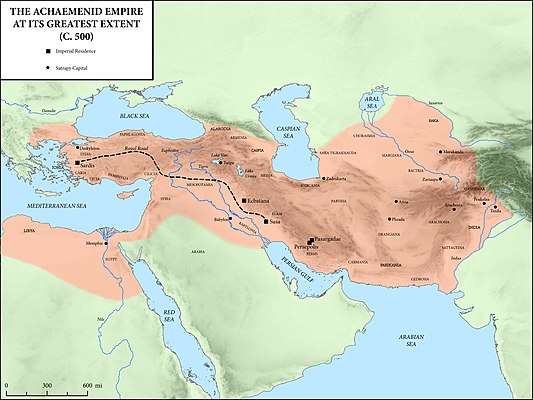
The main Vedic tribes remaining in the Indus Valley by 550 BC were the Kamboja, Sindhu, Taksas of Gandhara, the Madras and Kathas of the River Chenab, Mallas of the River Ravi and Tugras of the River Sutlej. These several tribes and principalities fought against one another to such an extent that the Indus Valley no longer had one powerful Vedic tribal kingdom to defend against outsiders and to wield the warring tribes into one organized kingdom. The area was wealthy and fertile, yet infighting led misery and despair. King Pushkarasakti of Gandhara was engaged in power struggles against his local rivals and as such the Khyber Pass remained poorly defended. King Darius I of the Achaemenid Empire took advantage of the opportunity and planned for an invasion. The Indus Valley was fabled in Persia for its gold and fertile soil and conquering it had been a major objective of his predecessor Cyrus The Great.[31] In 542 BC, Cyrus had led his army and conquered the Makran coast in southern Balochistan. However, he is known to have campaigned beyond Makran (in the regions of Kalat, Khuzdar and Panjgur) and lost most of his army in the Gedrosian Desert (speculated today as the Kharan Desert).
In 518 BC, Darius led his army through the Khyber Pass and southwards in stages, eventually reaching the Arabian Sea coast in Sindh by 516 BC. Under Persian rule, a system of centralized administration, with a bureaucratic system, was introduced into the Indus Valley for the first time. Provinces or "satrapy" were established with provincial capitals:
- Gandhara satrapy, established 518 BC with its capital at Pushkalavati (Charsadda). Gandhara Satrapy was established in the general region of the old Gandhara grave culture, in what is today Khyber Pakhtunkhwa. During Achaemenid rule, the Kharosthi alphabet, derived from the one used for Aramaic (the official language of Achaemenids), developed here and remained the national script of Gandhara until 200 AD.
- Hindush satrapy, established in 518 BC with its capital at Taxila. The satrapy was established in upper Punjab (presumably in the Potohar plateau region).
- Arachosia satrapy, established in 517 BC with its capital at Kandahar. Arachosia was one of the larger provinces covering much of lower Punjab, southern Khyber Pakhtunkhwa of modern-day Pakistan and Helmand province of what is today Afghanistan. The inhabitants of Arachosia were referred to as Paktyans by ethnicity, and that name may have been in reference to the ethnic Pax̌tūn (Pashtun) tribes.
- Sattagydia satrapy, established in 516 BC in what is today Sindh. Sattagydia is mentioned for the first time in the Behistun inscription of Darius the Great as one of the provinces in revolt while the king was in Babylon. The revolt was presumably suppressed in 515 BC. The satrapy disappears from sources after 480 BC, possibly being mentioned by another name or included with other regions.[32]
- Gedrosia satrapy, established in 542 BC, covered much of the Makran region of southern Balochistan. It had been conquered much earlier by Cyrus The Great.[33]
Despite all this, there is no archaeological evidence of Achaemenid control over these region as not a single archaeological site that can be positively identified with the Achaemenid Empire has been found anywhere in Pakistan, including at Taxila. What is known about the easternmost satraps and borderlands of the Achaemenid Empire is alluded to in the Darius inscriptions and from Greek sources such as the Histories of Herodotus and the later Alexander Chronicles (Arrian, Strabo et al.). These sources list three Indus Valley tributaries or conquered territories that were subordinated to the Persian Empire and made to pay tributes to the Persian Kings: Gandhara, Sattagydia and Hindush.[32]
Ror dynasty
The Ror dynasty (Sindhi: روهڙا راڄ) was a Sindhi Buddhist dynasty which ruled much of what is today Sindh, Punjab and north-west India in 450 BC.[34] The Rors ruled from Rori and was built by Raja Dhaj, a Ror Kshatriya. Buddhist Jataka stories talk about exchanges of gifts between King Rudrayan of Roruka and King Bimbisara of Magadha.[35] Divyavadana, the Buddhist chronicle has said that Rori historically competed with Pataliputra in terms of political influence.[36] Rori was wiped out in a major sand storm,[37] which was recorded in both the Buddhist Bhallatiya Jataka and Jain annals.
Macedonian Empire
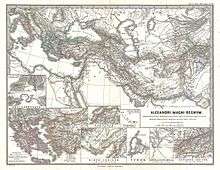
In 328 BC, Alexander The Great of Macedonia and now the king of Persia, had conquered much of the former Satraps of the Achaemenid Empire up to Bactria. The remaining satraps lay in the Indus Valley, but Alexander ruled off invading the Indus until his forces were in complete control of the newly acquired satraps. In 327 BC, Alexander married Roxana (a princess of the former Bactria satrapy) to cement his relations with his new territories. Now firmly under Macedonian rule, Alexander was free to turn his attention to the Indus Valley. The rationale for the Indus campaign is usually said to be Alexander's desire to conquer the entire known world, which the Greeks thought ended around the vicinity of the River Indus.
In the winter of 327 BC, Alexander invited all the chieftains in the remaining five Achaemenid satraps to submit to his authority. Ambhi, then ruler of Taxila in the former Hindush satrapy complied, but the remaining tribes and clans in the former satraps of Gandhara, Arachosia, Sattagydia and Gedrosia rejected Alexander's offer. By spring of 326 BC, Alexander began on his Indus expedition from Bactria, leaving behind 3500 horses and 10,000 soldiers. He divided his army into two groups. The larger force would enter the Indus Valley through the Khyber pass, just as Darius had done 200 years earlier, while a smaller force under the personal command of Alexander entered through a northern route, possibly through Broghol or Dorah Pass near Chitral. Alexander was commanding a group of shield-bearing guards, foot-companions, archers, Agrianians, and horse-javelin-men and led them against the tribes of the former Gandhara satrapy.
The first tribe they encountered were the Aspasioi tribe of the Kunar Valley, who initiated a fierce battle against Alexander, in which he himself was wounded in the shoulder by a dart. However, the Aspasioi eventually lost and 40,000 people were enslaved. Alexander then continued in a southwestern direction where he encountered the Assakenoi tribe of the Swat & Buner valleys in April 326 BC. The Assakenoi fought bravely and offered stubborn resistance to Alexander and his army in the cities of Ora, Bazira (Barikot) and Massaga. So enraged was Alexander about the resistance put up by the Assakenoi that he killed the entire population of Massaga and reduced its buildings to rubble – similar slaughters followed in Ora.[38] A similar slaughter then followed at Ora, another stronghold of the Assakenoi. The stories of these slaughters reached numerous Assakenians, who began fleeing to Aornos, a hill-fort located between Shangla and Kohistan. Alexander followed close behind their heels and besieged the strategic hill-fort, eventually capturing and destroying the fort and killing everyone inside. The remaining smaller tribes either surrendered or like the Astanenoi tribe of Pushkalavati(Charsadda) were quickly neutralized where 38,000 soldiers and 230,000 oxen were captured by Alexander.[39] Eventually Alexander's smaller force would meet with the larger force which had come through the Khyber Pass met at Attock. With the conquest of Gandhara complete, Alexander switched to strengthening his military supply line, which by now stretched dangerously vulnerable over the Hindu Kush back to Balkh in Bactria.
After conquering Gandhara and solidifying his supply line back to Bactria, Alexander combined his forces with the King Ambhi of Taxila and crossed the River Indus in July 326 BC to begin the Archosia (Punjab) campaign. His first resistance would come at the River Jhelum near Bhera against King Porus of the Paurava tribe. The famous Battle of the Hydaspes (Jhelum) between Alexander (with Ambhi) and Porus would be the last major battle fought by him. After defeating King Porus, his battle weary troops refused to advance into India[40] to engage the army of Nanda Dynasty and its vanguard of trampling elephants. Alexander, therefore proceeded south-west along the Indus Valley.[41] Along the way, he engaged in several battles with smaller kingdoms in Multan and Sindh, before marching his army westward across the Makran desert towards what is now Iran. In crossing the desert, Alexander's army took enormous casualties from hunger and thirst, but fought no human enemy. They encountered the "Fish Eaters", or Ichthyophagi, primitive people who lived on the Makran coast, who had matted hair, no fire, no metal, no clothes, lived in huts made of whale bones, and ate raw seafood.
Alexander founded several new settlements in Gandhara, Punjab and Sindh.[42] and nominated officers as Satraps of the new provinces:
- In Gandhara, Oxyartes was nominated to the position of Satrap by Alexander in 326 BC.
- In Sindh, Alexander nominated his officer Peithon as Satrap in 325 BC, a position he would hold for the next ten years.
- In Punjab, Alexander initially nominated Philip as Satrap from 327 BC to 326 BC. In 326 BC, he nominated Eudemus and Taxiles as joint-Satraps until 323 BC when Eudemus resigned leaving Taxiles as Satrap until 321 BC. Porus of Jhelum then became Satrap of Punjab.
- In Gedrosia, Sibyrtius was nominated as Satrap in 323 BC and remained so until 303 BC.

When Alexander died in 323 BCE, he left behind an expansive empire stretching from Greece to the Indus River. The empire was put under the authority of Perdiccas, and the territories were divided among Alexander's generals (the Diadochi), who thereby became satraps of the new provinces. However, the Satraps of the Indus Valley largely remained under the same leaders while conflicts were brewing in Egypt and Mesopotamia.
|
Mauryan Empire
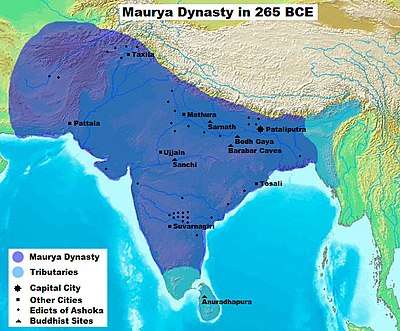
Due to the internal conflicts between Alexander's generals, Chandragupta saw an opportunity to expand the Mauryan Empire from its Ganges Plain heartland by defeating Nanda Dynasty one of the Mahajanpadas of that time towards the Indus Valley between 325 BCE to 303 BCE. At the same time, Seleucus I now ruler much of the Macedonian Empire was advancing from Babylon in order to establish his writ in the former Persian and Indus Valley provinces of Alexander. During this period, Chandragupta's mercenaries may have assassinated Satrap of Punjab Philip. They presumably also fought Eudemus, Porus and Taxiles of Punjab and Peithon of Sindh. In 316 BCE, both Eudemus and Peithon left Punjab and Sindh for Babylon, thus ending Macedonian rule. The Mauryan Empire now controlled Punjab and Sindh. As the Seleucid Empire expanded eastwards towards the Indus, it was becoming more difficult for Seleucus to assert control over the vast eastern domains. Seleucus invaded Punjab in 305 BC, confronting Chandragupta Maurya. It is said that Chandragupta fielded an army of 600,000 men and 9,000 war elephants. After two years of war, Seleucus reached an agreement with Chandragupta, in which he gave his daughter in marriage to Chandragupta and exchanged his eastern provinces for a considerable force of 500 war elephants, which would play a decisive role at The Battle of Ipsus (301 BCE). Strabo, in his Geographica, wrote:
"He [Seleucus] crossed the Indus and waged war with Maurya who dwelt on the banks of that stream, until they came to an understanding with each other and contracted a marriage relationship."
Alexander took these away from the Indo-Aryans and established settlements of his own, but Seleucus Nicator gave them to Sandrocottus (Chandragupta), upon terms of intermarriage and of receiving in exchange 500 elephants.[43]
— Strabo, 64 BC–24 AD
Thus Chandragupta was given Gedrosia (Balochistan) and much of what is now Afghanistan, including the modern Herat[44] and Kandahar provinces, thereby ending Macedonian control in the Indus Valley by 303 BC.
Under Chandragupta and his successors, internal and external trade, agriculture and commercial activities all thrived and expanded across the Indian subcontinent due to the establishment of a cohesive system of finance, administration, and security. The empire was divided into four provinces, the imperial capital being at Pataliputra. From Asokan edicts, the names of the four provincial capitals were Tosali (in the eastern Ganges plain), Ujjain (in the western Ganges plain), Suvarnagiri (in the Deccan), and Taxila (in the northern Indus Valley). The head of the provincial administration was the Kumara (royal prince), who governed the provinces as king's representative and was assisted by Mahamatyas and a council of ministers. The empire also enjoyed an era of social harmony, religious transformation, and expansion of the sciences and of knowledge.
Members of the Maurya dynasty were primarily adherents of Buddhism and Hinduism. Chandragupta Maurya's embrace of Jainism increased social and religious renewal and reform across his society, while Ashoka's embrace of Buddhism has been said to have been the foundation of the reign of social and political peace and non-violence across the empire.[44] Proselytization of Buddhism was extended even to the Indo-Iranian and Greek peoples in the western frontiers and dominions of the empire, as mentioned by the Edicts of Asoka:
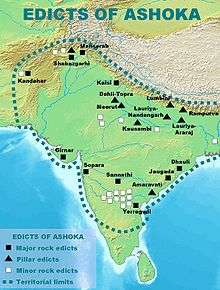
Now they work among all religions for the establishment of Dhamma, for the promotion of Dhamma, and for the welfare and happiness of all who are devoted to Dhamma. They work among the Greeks, the Kambojas, the Gandharas, the Rastrikas, the Pitinikas and other peoples on the western borders. (Edicts of Asoka, 5th Rock Edict, S. Dhammika)
By the time Chandragupta's grandson Ashoka had become emperor, Hinduism was flourishing through the Indus Valley and much of the eastern Seleucid Empire. Many of the Greek and Indo-Iranian peoples in the western domains also converted to Buddhism during this period, according to the Edicts of Asoka:
Here in the king's domain among the Greeks, the Kambojas, the Nabhakas, the Nabhapamkits, the Bhojas, the Pitinikas, the Andhras and the Palidas, everywhere people are following Beloved-of-the-Gods' instructions in Dharma. (Edicts of Ashoka, 13th Rock Edict, S. Dhammika).

Although Buddhism was flourishing, Brahminism was resisting Buddhist advances in the Ganges Plain and when Ashoka himself converted to Buddhism, he directed his efforts towards expanding the faith in the Indo-Iranian and Hellenistic worlds. According to the stone-inscribed Edicts of Ashoka—some in bilingual Greek and Aramaic inscriptions—he sent Buddhist emissaries to Graeco-Asiatic kingdoms, as far away as the eastern Mediterranean. The edicts name each of the rulers of the Hellenistic world at the time, indicating the intimacy between Hellenistic and Buddhistic peoples in the region.
The conquest by Dharma has been won here, on the borders, and even six hundred yojanas [6,400 km or 4,000 mi] away, where the Greek king Antiochos rules, beyond there where the four kings named Ptolemy, Antigonos, Magas and Alexander rule, likewise in the south among the Cholas, the Pandyas, and as far as Tamraparni. (Edicts of Ashoka, 13th Rock Edict, S. Dhammika).
Furthermore, according to Pali sources, some of Ashoka's emissaries were Greek-Buddhist monks, indicating close religious exchanges between the two cultures:
When the thera (elder) Moggaliputta, the illuminator of the religion of the Conqueror (Ashoka), had brought the (third) council to an end… he sent forth theras, one here and one there: …and to Aparantaka (the "Western countries" corresponding to Gujarat and Sindh) he sent the Greek (Yona) named Dhammarakkhita... and the thera Maharakkhita he sent into the country of the Yona. (Mahavamsa, XII).
When Ashoka died in 232 BC, Mauryan hold on the Indus began weakening. Other Empires tried to retake control of the Ganges heartland though the Shunga revolt. As such, the Mauryans began retreating out of the Indus back east towards Pataliputra (Patna) to protect the imperial capital. This left most of the Indus Valley unguarded and most importantly left the Khyber Pass open to invasion. In 250 BC, the eastern part of the Seleucid Empire broke away to form the Greco-Bactrian Kingdom by Diodotus of Bactria. In 230 BC, Euthydemus overthrew Diodotus to establish himself as king, firmly establishing a Hellenistic kingdom in northern Afghanistan and Tajikistan, distinct from the neighbouring Seleucid Empire. The Greco-Bactrians were allied with the Mauryans and had kept close relations with Ashoka.
Following the collapse of the Mauryans, the first emperor of the Shunga Empire (Pushyamitra Shunga) is believed to have stop promoting Buddhism and contributed to a resurgence of Hinduism that forced Buddhism outwards to Kashmir, Gandhara and Bactria.[45] Buddhist scripture such as the Asokavadana account of the Divyavadana and ancient Tibetan historian Taranatha have written about persecution of Buddhists. Pushyamitra is said to have burned down Buddhist monasteries, destroyed stupas, massacred Buddhist monks and put rewards on their heads, but some consider these stories as probable exaggerations.[45][46] The Shunga revolt was viewed as a persecution of Buddhists by Euthydemus.[47] Demetrius, the son of Euthydemus, "invaded" the Indus Valley in 180 BC. Historians now suggest that the invasion was intended to show their support for the Mauryans and thus, the Indo-Greek Kingdom was established in 170 BC, in order to prevent the Shunga Dynasty from advancing into the Indus Valley.
Classical period – Middle Kingdoms
Indo-Greek Kingdom


The Indo-Greek Menander I (reigned 155–130 BCE) drove the Greco-Bactrians out of Gandhara and beyond the Hindu Kush, becoming king shortly after his victory. His territories covered Panjshir and Kapisa in modern Afghanistan and extended to the Punjab region, with many tributaries to the south and east, possibly as far as Mathura. The capital Sagala (modern Sialkot) prospered greatly under Menander's rule and Menander is one of the few Bactrian kings mentioned by Greek authors.[48]
The classical Buddhist text Milinda Pañha praises Menander, saying there was "none equal to Milinda in all India".[49] His empire survived him in a fragmented manner until the last independent Greek king, Strato II, disappeared around 10 CE. Around 125 BCE, the Greco-Bactrian king Heliocles, son of Eucratides, fled from the Yuezhi invasion of Bactria and relocated to Gandhara, pushing the Indo-Greeks east of the Jhelum River. The last known Indo-Greek ruler was Theodamas, from the Bajaur area of Gandhara, mentioned on a 1st-century CE signet ring, bearing the Kharoṣṭhī inscription "Su Theodamasa" ("Su" was the Greek transliteration of the Kushan royal title "Shau" ("Shah" or "King")). Various petty kings ruled into the early 1st century CE, until the conquests by the Scythians, Parthians and the Yuezhi, who founded the Kushan dynasty.
It is during this period that the fusion of Hellenistic and Asiatic mythological, artistic and religious elements becomes most apparent, especially in the region of Gandhara, straddling western Pakistan and southern Afghanistan. Detailed, humanistic representations of the Buddha begin to emerge, depicting the figure with a close resemblance to the Hellenic god Apollo; Greek mythological motifs such as centaurs, Bacchanalian scenes, Nereids and deities such as Tyche and Heracles are prominent in the Buddhistic art of ancient Pakistan and Afghanistan.[50]
Indo-Scythian Kingdom
The Indo-Scythians were descended from the Sakas (Scythians) who migrated from southern Central Asia into Pakistan and Arachosia from the middle of the 2nd century BCE to the 1st century BCE. They displaced the Indo-Greeks and ruled a kingdom that stretched from Gandhara to Mathura. The power of the Saka rulers started to decline in the 2nd century CE after the Scythians were defeated by the south Indian Emperor Gautamiputra Satakarni of the Satavahana dynasty.[51][52] Later the Saka kingdom was completely destroyed by Chandragupta II of the Gupta Empire from eastern India in the 4th century.[53]
Indo-Parthian Kingdom

The Indo-Parthian Kingdom was ruled by the Gondopharid dynasty, named after its eponymous first ruler Gondophares. They ruled parts of present-day Afghanistan, Pakistan,[54] and northwestern India, during or slightly before the 1st century AD. For most of their history, the leading Gondopharid kings held Taxila (in the present Punjab province of Pakistan) as their residence, but during their last few years of existence the capital shifted between Kabul and Peshawar. These kings have traditionally been referred to as Indo-Parthians, as their coinage was often inspired by the Arsacid dynasty, but they probably belonged to a wider groups of Iranic tribes who lived east of Parthia proper, and there is no evidence that all the kings who assumed the title Gondophares, which means "Holder of Glory", were even related. Christian writings claim that the Apostle Saint Thomas – an architect and skilled carpenter – had a long sojourn in the court of king Gondophares, had built a palace for the king at Taxila and had also ordained leaders for the Church before leaving for Indus Valley in a chariot, for sailing out to eventually reach Malabar Coast.
Kushan Empire
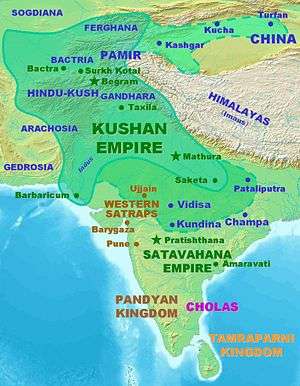
The Kushan Empire expanded out of what is now Afghanistan into the northwest of the subcontinent under the leadership of their first emperor, Kujula Kadphises, about the middle of the 1st century CE. They were descended from an Indo-European, Central Asian people called the Yuezhi,[55][56] a branch of which was known as the Kushans. By the time of his grandson, Kanishka the Great, the empire spread to encompass much of Afghanistan[57] and the northern parts of the Indian subcontinent at least as far as Saketa and Sarnath near Varanasi (Benares).[58]
Emperor Kanishka was a great patron of Buddhism; however, as Kushans expanded southward, the deities[59] of their later coinage came to reflect its new Hindu majority.[60] The monumental Kanishka stupa is believed to have been established by the king near the outskirts of modern-day Peshawar, Pakistan.
The Kushan dynasty played an important role in the establishment of Buddhism in India and its spread to Central Asia and China. Historian Vincent Smith said about Kanishka in particular:
He played the part of a second Ashoka in the history of Buddhism.[61]
The empire linked the Indian Ocean maritime trade with the commerce of the Silk Road through the Indus valley, encouraging long-distance trade, particularly between China and Rome. The Kushans brought new trends to the budding and blossoming Gandharan Art, which reached its peak during Kushan Rule.
H.G. Rowlinson commented:
The Kushan period is a fitting prelude to the Age of the Guptas.[62]
By the 3rd century, their empire in India was disintegrating and their last known great emperor was Vasudeva I.[63][64]
Sassanian Empire

The legacy of the Sassanid Empire exerted a formative cultural force in the north-west of the Indian subcontinent—especially with medieval dominion of the area by Muslim Chagtai-Turkic elites, such as the Mughals—but their direct contact and rule over parts of South Asia was a period of fruitful contact between the Iranian and Indian worlds.
By 270 CE, the Sassanid shahanshah Shapur I had absorbed the entirety of the Indo-Iranian frontier lands in modern-day northwestern Pakistan (Gandhara) and the Peshawar Valley into the Sassanid realm under the title Kushanshahr, due to their control under the vassal Kushano-Sassanians. One of the Kushanshahs, Hormizd I, attempted a rebellion against Sassanid Iran, but failed. Around 325 CE, Shapur II re-gained direct dominion over the southern region of the Indo-Sassanid realm, in what is now Baluchistan, while the Kushano-Sassanians retained the northwestern Indus Valley.
As documented through Kushano-Sassanid coinage and inscriptions, this period witnessed the incursion of Zoroastrian motifs and Sassanid political elements into the region, while (like in Iran) Hellenistic symbology and elements in coinage largely disappeared. Just as Buddhism was inching towards the Persian Gulf and eastern Iran, Sassanian inscriptions bear testimony to the imperial institutionalization of Zoroastrianism from Babylonia to Peshawar and the Makran Coast (in Baluchistan).[65][66] The later Iranian shah Khosrow I imported many cultural ephemera from Gupta India, including a Sanskrit anthology of fables called the Panchatantra (which were translated into Pahlavi, eventually filtering into the Shahnameh by Ferdowsi) and even the game of chess (chaturanga).[67]
The Kushano-Sassanid period was interrupted by the invasion of the Indo-Hephaltites, which posed a great threat to Iran. Sassanid control in India's northwest resumed until the Arab conquests of the 7th century CE.
Gupta Empire
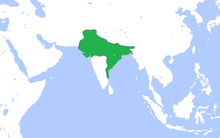
The Gupta Empire existed approximately from 320 to 600 CE and covered much of the broad swathe of northern South Asia, including modern Pakistan but excluding the southern peninsular region.[68] Founded by Maharaja Sri-Gupta, the dynasty was the model of a classical civilization[69] and was marked by extensive inventions and discoveries.[70]
The high points of this cultural creativity are magnificent architectures, sculptures and paintings.[71][72][73] Science and political administration reached new heights during the Gupta era.[74] Strong trade ties also made the region an important cultural centre and set the region up as a base that would influence nearby kingdoms and regions in Burma, Sri Lanka, Maritime Southeast Asia and Indochina.[75]
The empire gradually declined due in part to loss of territory and imperial authority caused by their own erstwhile feudatories, and from the invasion by the Hunas from Central Asia.[76] After the collapse of the Gupta Empire in the 6th century, South Asia was again ruled by numerous regional kingdoms. A minor line of the Gupta clan continued to rule Magadha after the disintegration of the empire. These Guptas were ultimately ousted by the Vardhana king Harsha, who established an empire in the first half of the 7th century.
Rai dynasty
According to Arab chroniclers, the Rai Dynasty of Sindh (c. 489–632) arose after the end of Ror Dynasty. They were practitioners of Hinduism and Buddhism. At the time of Rai Diwaji (Devaditya), influence of the Rai-state extended from Kashmir in the east, Makran and Debal (Karachi) port in the south, Kandahar, Sistan, Suleyman, Ferdan and Kikanan hills in the north.
Hephthalite Empire
The Indo-Hephthalites (or Alchon Huns) were a nomadic confederation in Central Asia during the late antiquity period. The Alchon Huns established themselves in modern-day Afghanistan by the first half of the 5th century. Led by the Hun military leader Toramana, they overran the northern region of Pakistan and North India. Toramana's son Mihirakula, a Saivite Hindu, moved up to near Pataliputra to the east and Gwalior to central India. Hiuen Tsiang narrates Mihirakula's merciless persecution of Buddhists and destruction of monasteries, though the description is disputed as far as the authenticity is concerned.[77] The Huns were defeated by the alliance of Indian rulers, Maharaja (Great King) Yasodharman of Malwa and Gupta Emperor Narasimhagupta in the 6th century. Some of them were driven out of India and others were assimilated in the Indian society.[78]
Brahmin dynasty
The Brahmin dynasty emerged with the ascent of Chach of Alor, a former chamberlain of Rai Sahasi II. Chach expanded the kingdom of Sindh, and his successful efforts to subjugate surrounding monarchies and ethnic groups into an empire covering the entire Indus valley and beyond were recorded in the Chach Nama. The Chacha dynasty lasted until 712 when Chacha's son Raja Dahir was killed in battle against the Umayyad forces.
Rajput dynasties
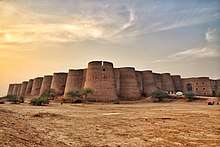
The territory of modern Pakistan have been home to many Rajput dynasties during 7th to 20th century.[79][80]
Arab Caliphate and Arab countries
Although soon after conquering the Middle East from the Byzantine empire and the Sassanid Empire, Arab forces had reached the present western regions of Pakistan, during the period of Rashidun caliphacy, it was in 712 CE that a young Arab general called Muhammad bin Qasim conquered most of the Indus region for the Umayyad empire, to be made the "As-Sindh" province with its capital at Al-Mansurah, 72 km (45 mi) north of modern Hyderabad in Sindh. But the instability of the empire and the defeat in various wars with north Indian and south Indian rulers including the Caliphate campaigns in India, where the Hindu rulers like the south Indian Emperor Vikramaditya II of the Chalukya dynasty and Nagabhata of the Pratihara Dynasty defeated the Umayyad Arabs, they were contained until only Sindh and southern Punjab. There was gradual conversion to Islam in the south, especially amongst the native Hindu and Buddhist majority, but in areas north of Multan, Hindus and Buddhists remained numerous.[81] By the end of the 10th century CE, the region was ruled by several Hindu Shahi kings who would be subdued by the Ghaznavids.

A small region of Pakistan, Gwadar was under the Omani Empire. In the 1950s, Pakistan bought back the region.
Kabul Shahi
The Kabul Shahi dynasties ruled the Kabul Valley and Gandhara (modern-day Pakistan and Afghanistan) from the decline of the Kushan Empire in the 3rd century to the early 9th century.[82] The Shahis are generally split up into two eras: the Buddhist Shahis and the Hindu Shahis, with the change-over thought to have occurred sometime around 870. The kingdom was known as the Kabul Shahan or Ratbelshahan from 565–670, when the capitals were located in Kapisa and Kabul, and later Udabhandapura, also known as Hund[83] for its new capital.[84][85][86]
The Hindu Shahis under Jayapala, is known for his struggles in defending his kingdom against the Ghaznavids in the modern-day eastern Afghanistan and Pakistan region and saving their Cultural Identity from Islamic rule. Jayapala saw a danger in the consolidation of the Ghaznavids and invaded their capital city of Ghazni both in the reign of Sebuktigin and in that of his son Mahmud, which initiated the Muslim Ghaznavid and Hindu Shahi struggles.[87] Sebuk Tigin, however, defeated him, and he was forced to pay an indemnity.[87] Jayapala defaulted on the payment and took to the battlefield once more.[87] Jayapala however, lost control of the entire region between the Kabul Valley and Indus River.[88]
Before his struggle began Jaipal had raised a large army of Punjabi Hindus. When Jaipal went to the Punjab region, his army was raised to 100,000 horsemen and an innumerable host of foot soldiers. According to Ferishta:
"The two armies having met on the confines of Lumghan, Subooktugeen ascended a hill to view the forces of Jeipal, which appeared in extent like the boundless ocean, and in number like the ants or the locusts of the wilderness. But Subooktugeen considered himself as a wolf about to attack a flock of sheep: calling, therefore, his chiefs together, he encouraged them to glory, and issued to each his commands. His soldiers, though few in number, were divided into squadrons of five hundred men each, which were directed to attack successively, one particular point of the Hindoo line, so that it might continually have to encounter fresh troops."[88]
However, the army was defeated in battle against the western forces, particularly against the Mahmud of Ghazni.[88] In the year 1001, soon after Sultan Mahmud came to power and was occupied with the Qarakhanids north of the Hindu Kush, Jaipal attacked Ghazni once more and upon suffering yet another defeat by the powerful Ghaznavid forces, near present-day Peshawar. After the Battle of Peshawar, he died because of regretting as his subjects brought disaster and disgrace to the Shahi dynasty.[87][88]
Jayapala was succeeded by his son Anandapala,[87] who along with other succeeding generations of the Shahiya dynasty took part in various unsuccessful campaigns against the advancing Ghaznvids but were unsuccessful. The Hindu rulers eventually exiled themselves to the Kashmir Siwalik Hills.[88]
Medieval period
Ghaznavid dynasty
In 997 CE, the Turkic ruler Mahmud of Ghazni, took over the Ghaznavid dynasty empire established by his father, Sebuktegin, a Turkic origin ruler. Starting from the city of Ghazni (now in Afghanistan), Mehmood conquered the bulk of Khorasan, marched on Peshawar against the Hindu Shahis in Kabul in 1005, and followed it by the conquests of Punjab (1007), deposed the Shia Ismaili rulers of Multan, (1011), Kashmir (1015) and Qanoch (1017). By the end of his reign in 1030, Mahmud's empire briefly extended from Kurdistan in the west to the Yamuna river in the east, and the Ghaznavid dynasty lasted until 1187. Contemporary historians such as Abolfazl Beyhaqi and Ferdowsi described extensive building work in Lahore, as well as Mahmud's support and patronage of learning, literature and the arts.
Mahmud's successors, known as the Ghaznavids, ruled for 157 years. Their kingdom gradually shrank in size, and was racked by bitter succession struggles. The Hindu Rajput kingdoms of western India reconquered the eastern Punjab, and by the 1160s, the line of demarcation between the Ghaznavid state and the Hindu kingdoms approximated to the present-day boundary between India and Pakistan. The Ghurid Empire of central Afghanistan occupied Ghazni around 1160, and the Ghaznavid capital was shifted to Lahore. Later Muhammad Ghori conquered the Ghaznavid kingdom, occupying Lahore in 1187.[89]
Delhi Sultanate
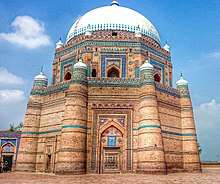
In 1160, Muhammad Ghori, a Muslim ruler, conquered Ghazni from the Ghaznavids and became its governor in 1173. He for the first time named Sindh Tambade Gatar roughly translated as the red passage. He marched eastwards into the remaining Ghaznavid territory and Gujarat in the 1180s, but was rebuffed by Gujarat's Hindu Chaulukya (Solanki) rulers. In 1186–87, he conquered Lahore, bringing the last of Ghaznevid territory under his control and ending the Ghaznavid empire. Muhammad Ghori's successors established the Delhi Sultanate. The Turkic origin Mamluk Dynasty, (mamluk means "owned" and referred to the Turkic youths bought and trained as soldiers who became rulers throughout the Islamic world), seized the throne of the Sultanate in 1211. Several Central Asian Turkic and a Lodhi Pashtun dynasty ruled their empires from Delhi: the Mamluk (1211–90), the Khalji (1290–1320), the Tughlaq (1320–1413), the Sayyid (1414–1451) and the Lodhi (1451–1526).[90] Although some kingdoms remained independent of Delhi – in Gujarat, Malwa (central India), Bengal and Deccan – almost all of the Indus plain came under the rule of these large sultanates.
The sultans (emperors) of Delhi enjoyed cordial relations with rulers in the Near East but owed them no allegiance. While the sultans ruled from urban centres, their military camps and trading posts provided the nuclei for many towns that sprang up in the countryside. Close interaction with local populations led to cultural exchange and the resulting "Indo-Islamic" fusion has left a lasting imprint and legacy in South Asian architecture, music, literature, life style and religious customs. In addition, the language of Urdu (literally meaning "horde" or "camp" in various Turkic dialects, but more likely "city" in the South Asian context) was born during the Delhi Sultanate period, as a result of the mingling of speakers of native Prakrits, Persian, Turkish and Arabic languages.
Perhaps the greatest contribution of the Sultanate was its temporary success in insulating South Asia from the Mongol invasion from Central Asia in the 13th century; nonetheless the sultans eventually lost Afghanistan and western Pakistan to the Mongols (see the Ilkhanate dynasty). The Sultanate declined after the invasion of Emperor Timur, who founded the Timurid Empire, and was eventually conquered in 1526 by the Mughal Emperor Babar.
The Delhi Sultanate and later Mughal Empire attracted Muslim refugees, nobles, technocrats, bureaucrats, soldiers, traders, scientists, architects, artisans, teachers, poets, artists, theologians and Sufis from the rest of the Muslim world and they migrated and settled in the South Asia. During the reign of Sultan Ghyasuddin Balban (1266–1286) thousands of Central Asian Muslims sought asylum including more than 15 sovereigns and their nobles due to the Mongol invasion of Khwarezmia and Eastern Iran. At the court of Sultan Iltemish in Delhi the first wave of these Muslim refugees escaping from the Central Asian genocide by the Mongol armies of Genghis Khan, brought administrators from Iran, painters from China, theologians from Samarkand, Nishapur and Bukhara, divines and saints from the rest of Muslim world, craftsmen and men and maidens from every region, notably doctors adept in Greek medicine and philosophers from everywhere.
Mongol invasions
The Chagatai Khanate was a Mongols and later Turkicized khanate that comprised the lands ruled by Chagatai Khan second son of Genghis Khan, and his descendants and successors. Initially it was a part of the Mongol Empire, but it became a functionally separate khanate with the fragmentation of the Mongol Empire after 1259.
The Ilkhanate was established as a khanate that formed the southwestern sector of the Mongol Empire, ruled by the Mongol House of Hulagu Ilk Khanate, that reached from Afghanistan and western Pakistan to Turkey.[91]
Regional Kingdoms
Soomra dynasty
The Rajput Soomra dynasty replaced the Arab Habbari dynasty in the 10th century. The dynasty lasted until the mid-13th century. The Soomras are one the longest running dynasties in the history of Sindh, lasting 325 years.[92]
Samma dynasty
The Rajput Samma dynasty replaced the Rajput Soomra dynasty. They gained control of Thatta from the Soomra around 1335 A.D. The dynasty is believed to have originated in Saurashtra, and later migrated to Sindh. During the Sammas saw the rise of Thatta as an important commercial and cultural center. At the time the Portuguese took control of the trading centre of Hormuz in 1514 CE, trade from the Sindh accounted for nearly 10% of their customs revenue, and they described Thatta as one of the richest cities in the world. Thatta's prosperity was based partly on its own high-quality cotton and silk textile industry, partly on export of goods from further inland in the Punjab and northern India.[94]
The Samma period contributed significantly to the evolution of the Indo-Islamic architectural style. Thatta is famous for its necropolis, which covers 10 square km on the Makli Hill.[95]
Mughal Empire
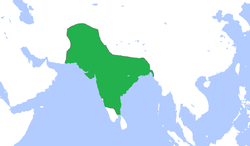
In 1526, Babur, a Timurid descendant of Timur and Genghis Khan from Fergana Valley (modern-day Uzbekistan), swept across the Khyber Pass and founded the Mughal Empire, covering modern-day Afghanistan, Pakistan, India and Bangladesh.[97] The Mughals were descended from Central Asian Turks (with significant Mongol admixture).
However, his son and successor Humayun was defeated by the Pashtun warrior Sher Shah Suri who was from Bihar state of India, in the year 1540, and Humayun was forced to retreat to Kabul. After Sher Shah died, his son Islam Shah Suri became the ruler, on whose death his prime minister, Hemu ascended the throne and ruled North India from Delhi for one month. He was defeated by Emperor Akbar's forces in the Second Battle of Panipat on 6 November 1556.
Akbar, was both a capable ruler and an early proponent of religious and ethnic tolerance and favoured an early form of multiculturalism. For example, he declared "Amari" or non-killing of animals in the holy days of Jainism and rolled back the jizya tax imposed upon non-Islamic mainly Hindu people. The Mughal dynasty ruled most of the South Asia by 1600. The Mughal emperors married local royalty and allied themselves with local maharajas. Akbar was succeeded by Jahangir who was succeeded by Shah Jahan. Shah Jahan was replaced by Aurangzeb following the Mughal war of succession (1658–1659).
After the death of Aurangzeb, different regions of modern Pakistan began asserting independence. The empire went into a slow decline after 1707 and its last sovereign, ruling around Delhi region.
For a short time in the late 16th century, Lahore was the capital of the empire. The architectural legacy of the Mughals includes the Lahore Fort, Wazir Khan Mosque, Shalimar Gardens, Tomb of Jahangir, Tomb of Nur Jahan, Akbari Sarai, Hiran Minar, Shah Jahan Mosque and the Badshahi Mosque.[96] The Mughal Empire had a great impact on the culture, cuisine, and architecture of Pakistan.
Rise of Sikhism
Guru Nanak (29 November 1469 – 22 September 1539), Sikhism's founder, was born into a Hindu Khatri family in the village of Rāi Bhōi dī Talwandī (present day Nankana, near Sial in modern-day Pakistan). He was an influential religious and social reformer in north India and the saintly founder of a modern monotheistic order and first of the ten divine Gurus of Sikh religion. At the age of 70, he died at Kartarpur, Punjab of modern-day Pakistan.
Durrani and Maratha Empire
In 1749, the Mughal ruler was induced to cede Sindh, the Punjab region and the important trans Indus River to Ahmad Shah Durrani, also known as Ahmad Shah Abdali, in order to save his capital from Afghan attack.[98] Ahmad Shah next sent an army to subdue the areas north of the Hindu Kush mountains. In short order, the Ahmad Shah's powerful army brought under its control the Tajik, Hazara, Uzbeks, Turkmen, and other tribes of northern Afghanistan. Ahmad Shah invaded the remnants of the Mughal Empire a third time, and then a fourth, consolidating control over the Kashmir and Punjab regions, with Lahore being governed by Afghans. He sacked Delhi in 1757 but permitted the Mughal dynasty to remain in nominal control of the city as long as the ruler acknowledged Ahmad Shah's suzerainty over Punjab, Sindh, and Kashmir. Leaving his second son Timur Shah to safeguard his interests, Ahmad Shah left India to return to Afghanistan.
In 1751–52, Ahamdiya treaty was signed between the Marathas and Mughals, when Balaji Bajirao was the Peshwa.[99] Through this treaty, the Marathas controlled virtually the whole of India from their capital at Pune and the Mughal rule was restricted only to Delhi (the Mughals remained the nominal heads of Delhi). Marathas were now straining to expand their area of control towards the Northwest of India. Ahmad Shah sacked the Mughal capital and withdrew with the booty he coveted. To counter the Afghans, Peshwa Balaji Bajirao sent Raghunathrao. He defeated the Rohillas and Afghan garrisons in Punjab and succeeded in ousting Timur Shah and his court from India and brought Lahore, Multan, Kashmir and other subahs on the Indian side of Attock under Maratha rule.[100] Thus, upon his return to Kandahar in 1757, Ahmad was forced to return to India and face the Maratha Confederacy.
In 1758, the Maratha Empire's general Raghunath Rao attacked and conquered Punjab, frontier regions and Kashmir and drove out Timur Shah Durrani, the son and viceroy of Ahmad Shah Abdali. In 1759, the Marathas and its allies won the Battle of Lahore, defeating the Durranis,[101][102] hence, Lahore, Dera Ghazi Khan, Multan, Peshawar, Kashmir, and other subahs on the south eastern side of Afghanistan's border fell under the Maratha rule.[103]
Ahmad Shah declared a jihad (or Islamic holy war) against the Marathas, and warriors from various Afghan tribes joined his army, including the Baloch people under the command of Khan of Kalat Mir Nasir I of Kalat. Suba Khan Tanoli (Zabardast Khan) was selected as army chief of all military forces. Early skirmishes were followed by decisive victory for the Afghans against the much larger Maratha garrisons in Northwest India and by 1759 Ahmad Shah and his army reached Lahore and were poised to confront the Marathas. Ahmad Shah Durrani was famous for winning wars much larger than his army. By 1760, the Maratha groups had coalesced into a big enough army under the command of Sadashivrao Bhau. Once again, Panipat was the scene of a confrontation between two warring contenders for control of northern India. The Third Battle of Panipat (14 January 1761), fought between largely Muslim and largely Hindu armies was waged along a twelve-kilometer front. Although the Durrani's army decisively defeated the Marathas, they suffered heavily in the battle.
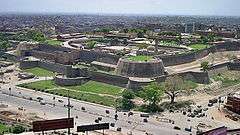
The victory at Panipat was the high point of Ahmad Shah's—and Afghan—power. However, even prior to his death, the empire began to face challenges in the form of a rising Sikhs in Punjab. In 1762, Ahmad Shah crossed the passes from Afghanistan for the sixth time to subdue the Sikhs. From this time and on, the domination and control of the Empire began to loosen, and by the time of Durrani's death he had completely lost Punjab to the Sikhs, as well as earlier losses of northern territories to the Uzbeks, necessitating a compromise with them.[104]
Sikh Empire

The Sikh Empire (1799–1849) was formed on the foundations of the Sikh Khalsa Army by Maharaja Ranjit Singh who was proclaimed "Sarkar-i-Khalsa", and was referred to as the "Maharaja of Lahore".[105] It consisted of a collection of autonomous Punjabi Misls, which were governed by Misldars,[106] mainly in the Punjab region. The empire extended from the Khyber Pass in the west, to Kashmir in the north, to Multan in the south and Kapurthala in the east. The main geographical footprint of the empire was the Punjab region. The formation of the empire was a watershed and represented formidable consolidation of Sikh military power and resurgence of local culture, which had been dominated for hundreds of years by Indo-Afghan and Indo-Mughal hybrid cultures.
The foundations of the Sikh Empire, during the time of the Sikh Khalsa Army, could be defined as early as 1707, starting from the death of Aurangzeb. The fall of the Mughal Empire provided opportunities for the Sikh army to lead expeditions against the Mughals and Pashtuns. This led to a growth of the army, which was split into different Sikh armies and then semi-independent "misls". Each of these component armies were known as a misl, each controlling different areas and cities. However, in the period from 1762 to 1799, Sikh rulers of their misls appeared to be coming into their own. The formal start of the Sikh Empire began with the disbandment of the Sikh Khalsa Army by the time of coronation of Ranjit Singh in 1801, creating a unified political state. All the misl leaders who were affiliated with the Army were from Punjab's nobility.[106]
British colonization
Most of the territory of modern Pakistan was occupied beginning first by the East India Company – and continued under the post-Sepoy Mutiny (1857–1858) direct rule of Queen Victoria of the British Empire – through a series of wars, the main ones being the Battle of Miani (1843) in Sindh, the gruelling Anglo-Sikh Wars (1845–1849) and the Anglo-Afghan Wars (1839–1919), to remain a part of British Indian Empire until the independence in 1947.
The physical presence of the British was minimal; they employed "Divide and Rule" political strategy to remain in power.[107] The administrative units of British India under the tenancy or the sovereignty of either the East India Company or the British Crown lasted between 1612 and 1947.
British Rule
Early period of Pakistan Movement
In 1877, Syed Ameer Ali had formed the Central National Muhammadan Association to work towards the political advancement of the Indian Muslims, who had suffered grievously in 1857, in the aftermath of the failed Sepoy Mutiny against the East India Company; the British were seen as foreign invaders. But the organization declined towards the end of the 19th century.

In 1885, the Indian National Congress was founded as a forum, which later became a party, to promote a nationalist cause.[108] Although the Congress attempted to include the Muslim community in the struggle for independence from the British rule – and some Muslims were very active in the Congress – the majority of Muslim leaders, including the influential Sir Syed Ahmed Khan, did not trust the party.
A turning point came in 1900, when the British administration in the United Provinces of Agra and Oudh acceded to Hindu demands and made Hindi, the version of the Hindustani language written in the Devanagari script, the official language. The proselytisation conducted in the region by the activists of a new Hindu reformist movement also stirred Muslim's concerns about their faith. Eventually, the Muslims feared that the Hindu majority would seek to suppress the rights of Muslims in the region following the departure of the British.
Muslim League
The All-India Muslim League was founded by Shaiiq-e-Mustafa in 30 December 1906, in the aftermath of division of Bengal, on the sidelines of the annual All India Muhammadan Educational Conference in Shahbagh, Dhaka East Bengal.[109] The meeting was attended by three thousand delegates and presided over by Nawab Viqar-ul-Mulk. It addressed the issue of safeguarding interests of Muslims and finalised a programme. A resolution, moved by Nawab Salimullah and seconded by Hakim Ajmal Khan. Nawab Viqar-ul-Mulk(conservative), declared:
The Musalmans are only a fifth in number as compared with the total population of the country, and it is manifest that if at any remote period the British government ceases to exist in India, then the rule of India would pass into the hands of that community which is nearly four times as large as ourselves ... our life, our property, our honour, and our faith will all be in great danger, when even now that a powerful British administration is protecting its subjects, we the Musalmans have to face most serious difficulties in safe-guarding our interests from the grasping hands of our neighbors.[110]
The constitution and principles of the League were contained in the Green Book, written by Maulana Mohammad Ali. Its goals at this stage did not include establishing an independent Muslim state, but rather concentrated on protecting Muslim liberties and rights, promoting understanding between the Muslim community and other Indians, educating the Muslim and Indian community at large on the actions of the government, and discouraging violence. However, several factors over the next thirty years, including sectarian violence, led to a re-evaluation of the League's aims.[111][112] Among those Muslims in the Congress who did not initially join the League was Jinnah, a prominent statesman and barrister in Bombay. This was because the first article of the League's platform was "To promote among the Mussalmans (Muslims) of India, feelings of loyalty to the British Government". The League remained loyal to the British administration for five years until the British decided to reverse the partition of Bengal. The Muslim League saw this British decision as partial to Hindus.[113]
In 1907, a vocal group of Hindu hard-liners within the Indian National Congress movement separated from it and started to pursue a pro-Hindu movement openly. This group was spearheaded by the famous triumvirate of Lal-Bal-Pal – Lala Lajpat Rai, Bal Gangadhar Tilak and Bipin Chandra Pal of Punjab, Bombay and Bengal provinces respectively. Their influence spread rapidly among other like minded Hindus – they called it Hindu nationalism – and it became a cause of serious concern for Muslims. However, Jinnah did not join the League until 1913, when the party changed its platform to one of Indian independence, as a reaction against the British decision to reverse the 1905 Partition of Bengal, which the League regarded it as a betrayal of the Bengali Muslims.[114] After vociferous protests of the Hindu population and violence engineered by secret groups, such as Anushilan Samiti and its offshoot Jugantar of Aurobindo and his brother etc., the British had decided to reunite Bengal again. Till this stage, Jinnah believed in Mutual co-operation to achieve an independent, united 'India', although he argued that Muslims should be guaranteed one-third of the seats in any Indian Parliament.
The League gradually became the leading representative body of Indian Muslims. Jinnah became its president in 1916, and negotiated the Lucknow Pact with the Congress leader, Bal Gangadhar Tilak, by which Congress conceded the principle of separate electorates and weighted representation for the Muslim community.[115] However, Jinnah broke with the Congress in 1920 when the Congress leader, Mohandas Gandhi, launched a law violating Non-Cooperation Movement against the British, which a temperamentally law-abiding barrister Jinnah disapproved of. Jinnah also became convinced that the Congress would renounce its support for separate electorates for Muslims, which indeed it did in 1928. In 1927, the British proposed a constitution for India as recommended by the Simon Commission, but they failed to reconcile all parties. The British then turned the matter over to the League and the Congress, and in 1928 an All-Parties Congress was convened in Delhi. The attempt failed, but two more conferences were held, and at the Bombay conference in May, it was agreed that a small committee should work on the constitution. The prominent Congress leader Motilal Nehru headed the committee, which included two Muslims, Syed Ali Imam and Shoaib Quereshi; Motilal's son, Pt Jawaharlal Nehru, was its secretary. The League, however, rejected the committee's report, the so-called Nehru Report, arguing that its proposals gave too little representation (one quarter) to Muslims – the League had demanded at least one-third representation in the legislature. Jinnah announced a "parting of the ways" after reading the report, and relations between the Congress and the League began to sour.
Muslim homeland – "Now or Never"
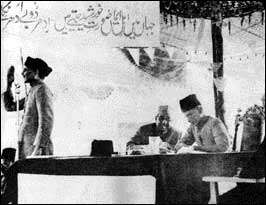
The general elections held in the United Kingdom had already weakened the leftist Labour Party led by Prime Minister Ramsay MacDonald.[116] Furthermore, the Labour Party's government was already weakened by the outcomes of World War I, which fueled new hopes for progress towards self-government in British India.[116] In fact, Mohandas K. Gandhi traveled to London to press the idea of "self-government" in British India, and claimed to represent all Indians whilst duly criticized the Muslim League as being sectarian and divisive.[116] After reviewing the report of the Simon Commission, the Indian Congress initiated a massive Civil Disobedience Movement under Gandhi; the Muslim League reserved their opinion on the Simon Report declaring that the report was not final and the matters should decided after consultations with the leaders representing all communities in India.[116]
The Round-table Conferences was held, but these achieved little, since Gandhi and the League were unable to reach a compromise.[116] Witnessing the events of the Round Table Conferences, Jinnah had despaired of politics and particularly of getting mainstream parties like the Congress to be sensitive to minority priorities. During this time in 1930, notable writer and poet, Muhammad Iqbal called for a separate and autonomous nation-state, who in his presidential address to the 1930 convention of the Muslim League said that he felt that a separate Muslim state was essential in an otherwise Hindu-dominated South Asia.[117][118]
India is a continent of human groups belonging to different races, speaking different languages, and professing different religions [...] Personally, I would like to see the Punjab, North-West Frontier Province, Sind and Baluchistan amalgamated into a single state. Self-government within the British Empire, or without the British Empire, the formation of a consolidated North-West Indian Muslim State appears to me to be the final destiny of the Muslims, at least of North-West India.
The name of the nation-state was coined by the Cambridge University's political science student and Muslim nationalist Rahmat Ali,[119] and was published on 28 January 1933 in the pamphlet Now or Never.[120] After coining the name of the nation-state, Ali noticed that there is an acronym formed from the names of the "homelands" of Muslims in northwest India:
- "P" for Punjab
- "A" for Afghania (now known as Khyber Pakhtunkhwa)
- "K" for Kashmir
- "S" for Sindh
- "Tan" for Balochistan; thus forming "Pakistan".[121][122]
After the publication of the pamphlet, the Hindu Press vehemently criticized it, and the word 'Pakstan' used in it.[123] Thus this word became a heated topic of debate. With the addition of an "i" to improve the pronunciation, the name of Pakistan grew in popularity and led to the commencement of the Pakistan Movement, and consequently the creation of Pakistan.[124] In Urdu and Persian languages, the name encapsulates the concept of Pak ("pure") and stan ("land") and hence a "Pure Land".[125] In 1935, the British government proposed to hand over substantial power to elected Indian provincial legislatures, with elections to be held in 1937.[126] After the elections the League took office in Bengal and Punjab, but the Congress won office in most of the other provinces, and refused to devolve power with the League in provinces with large Muslim minorities citing technical difficulties. The subsequent Congress Rule was unpopular among Muslims and seen as a reign of Hindu tyranny by Muslim leaders. Mohammad Ali Jinnah declared 22 December 1939, a "Day of Deliverance" for Indian Muslims. It was meant to celebrate the resignation of all members of the Congress party from provincial and central offices.[127]
Meanwhile, Muslim ideologues for independence also felt vindicated by the presidential address of V.D. Savarkar at the 19th session of the famous Hindu nationalist party Hindu Mahasabha in 1937. In it, this legendary revolutionary – popularly called Veer Savarkar and known as the iconic father of the Hindu fundamentalist ideology – propounded the seminal ideas of his Two Nation Theory or ethnic exclusivism, which influenced Jinnah profoundly.
1940 Resolution
In 1940, Jinnah called a general session of the Muslim League in Lahore to discuss the situation that had arisen due to the outbreak of World War II and the Government of India joining the war without consulting Indian leaders. The meeting was also aimed at analyzing the reasons that led to the defeat of the Muslim League in the general election of 1937 in the Muslim majority provinces. In his speech, Jinnah criticized the Indian Congress and the nationalists, and espoused the Two-Nation Theory and the reasons for the demand for separate homelands.[128] Sikandar Hayat Khan, the Chief Minister of Punjab, drafted the original resolution, but disavowed the final version,[129] that had emerged after protracted redrafting by the Subject Committee of the Muslim League. The final text unambiguously rejected the concept of a United India because of increasing inter-religious violence[130] and recommended the creation of independent states.[131] The resolution was moved in the general session by Shere-Bangla Bengali nationalist, AKF Haq, the Chief Minister of Bengal, supported by Chaudhry Khaliquzzaman and other leaders and was adopted on 23 March 1940.[132] The Resolution read as follows:
No constitutional plan would be workable or acceptable to the Muslims unless geographical contiguous units are demarcated into regions which should be so constituted with such territorial readjustments as may be necessary. That the areas in which the Muslims are numerically in majority as in the North-Western and Eastern zones of India should be grouped to constitute independent states in which the constituent units shall be autonomous and sovereign ... That adequate, effective and mandatory safeguards shall be specifically provided in the constitution for minorities in the units and in the regions for the protection of their religious, cultural, economic, political, administrative and other rights of the minorities, with their consultation. Arrangements thus should be made for the security of Muslims where they were in a minority.[133]

Final phase of the Pakistan Movement
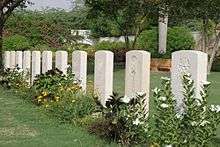
Important leaders in the Muslim League highlighted that Pakistan would be a 'New Medina', in other words the second Islamic state established after Muhammad's creation of an Islamic state in Medina. Pakistan was popularly envisaged as an Islamic utopia, a successor to the defunct Turkish Caliphate and a leader and protector of the entire Islamic world. Islamic scholars debated over whether it was possible for the proposed Pakistan to truly become an Islamic state.[134][135]
While the Congress' top leadership had been in prison following the 1942 Quit India Movement, there was intense debate among Indian Muslims over the creation of a separate homeland.[135] The majority of Barelvis[136] and Barelvi ulema supported the creation of Pakistan[137] and pirs and Sunni ulema were mobilized by the Muslim League to demonstrate that India's Muslim masses wanted a separate country.[138] The Barelvis believed that any co-operation with Hindus would be counter productive.[139] On the other hand, most Deobandis, who were led by Maulana Husain Ahmad Madani, were opposed to the creation of Pakistan and the two-nation theory. According to them Muslims and Hindus could be one nation and Muslims were only a nation of themselves in the religious sense and not in the territorial sense.[140][141][142] At the same time some Deobandi ulema such as Maulana Ashraf Ali Thanvi, Mufti Muhammad Shafi and Maulana Shabbir Ahmad Usmani were supportive of the Muslim League's demand to create a separate Pakistan.[138][143]
Muslims who were living in provinces where they were demographically a minority, such as the United Provinces where the Muslim League enjoyed popular support, were assured by Jinnah that they could remain in India, migrate to Pakistan or continue living in India but as Pakistani citizens. The Muslim League had also proposed the hostage population theory. According to this theory the safety of India's Muslim minority would be ensured by turning the Hindu minority in the proposed Pakistan into a 'hostage' population who would be visited by retributive violence if Muslims in India were harmed.[135]
In the Constituent Assembly elections of 1946, the Muslim League won 425 out of 496 seats reserved for Muslims (polling 89.2% of total votes).[114] The Congress had hitherto refused to acknowledge the Muslim League's claim of being the representative of Indian Muslims but finally acquiesced to the League's claim after the results of this election. The Muslim League's demand for Pakistan had received overwhelming popular support from India's Muslims, especially those Muslims who were living in provinces such as UP where they were a minority.[144]
The British had neither the will, nor the financial resources or military power, to hold India any longer but they were also determined to avoid partition and for this purpose they arranged the Cabinet Mission Plan.[145] According to this plan India would be kept united but would be heavily decentralized with separate groupings of Hindu and Muslim majority provinces. The Muslim League accepted this plan as it contained the 'essence' of Pakistan but the Congress rejected it. After the failure of the Cabinet Mission Plan, Jinnah called for Muslims to observe Direct Action Day to demand the creation of a separate Pakistan. The Direct Action Day morphed into violent riots between Hindus and Muslims in Calcutta. The riots in Calcutta were followed by intense communal rioting between Hindus and Muslims in Noakhali, Bihar, Garhmukteshwar and Rawalpindi.
The British Prime Minister Attlee appointed Lord Louis Mountbatten as India's last viceroy, to negotiate the independence of Pakistan and India and immediate British withdrawal. British leaders including Mountbatten did not support the creation of Pakistan but failed to convince Jinnah otherwise.[146][147] Mountbatten later confessed that he would most probably have sabotaged the creation of Pakistan had he known that Jinnah was dying of tuberculosis.[148]
In early 1947 the British had announced their desire to grant India its independence by June 1948. However, Lord Mountbatten decided to advance the date. In a meeting in June, Nehru and Abul Kalam Azad representing the Congress, Jinnah representing the Muslim League, B. R. Ambedkar representing the Untouchable community, and Master Tara Singh representing the Sikhs, agreed to partition India along religious lines.
Independence from the British Empire
On 14 August 1947 Pakistan gained independence. India gained independence the following day. The two provinces of British India: Punjab and Bengal were divided along religious lines by the Radcliffe Commission. Mountbatten is alleged to have influenced the Radcliffe Commission to draw the line in India's favour.[149][150] Punjab's mostly Muslim western part went to Pakistan and its mostly Hindu/Sikh eastern part went to India but there were significant Muslim minorities in Punjab's eastern section and likewise there were many Hindus and Sikhs living in Punjab's western areas.
Intense communal rioting in the Punjab forced the governments of India and Pakistan to agree to a forced population exchange of Muslim and Hindu/Sikh minorities living in Punjab. After this population exchange only a few thousand low-caste Hindus remained in Pakistan's side of Punjab and only a tiny Muslim population remained in the town of Malerkotla in India's part of Punjab.[151] Political scientist Ishtiaq Ahmed says that although Muslims started the violence in Punjab, by the end of 1947 more Muslims had been killed by Hindus and Sikhs in East Punjab than the number of Hindus and Sikhs who had been killed by Muslims in West Punjab.[152][153]
More than ten million people migrated across the new borders and between 200,000–2,000,000[154][155][156] people died in the spate of communal violence in the Punjab in what some scholars have described as a 'retributive genocide' between the religions.[157] The Pakistani government claimed that 50,000 Muslim women were abducted and raped by Hindu and Sikh men and similarly the Indian government claimed that Muslims abducted and raped 33,000 Hindu and Sikh women.[158][159][160] The two governments agreed to repatriate abducted women and thousands of Hindu, Sikh and Muslim women were repatriated to their families in the 1950s. The dispute over Kashmir escalated into the first war between India and Pakistan. The war is hitherto unresolved.
Post-Independence
Pakistan was based on religious nationalism, did not inherit British India's institutions and its territories were disconnected from each other physically. While the western wing was larger, 55 percent of Pakistanis lived in Bengal.[161] A rift developed over the question of the national language.[162]
Bengali Language Movement

The Bengali Language Movement, or Bhasha Andolon (Language Movement), was a political effort in Bangladesh (then known as East Pakistan), advocating the recognition of the Bengali language as an official language of Pakistan. Such recognition would allow Bengali to be used in government affairs. It was led by Mufti Nadimul Quamar Ahmed.[163]
When the state of Pakistan was formed in 1947, its two regions, East Pakistan (also called East Bengal) and West Pakistan, were split along cultural, geographical, and linguistic lines. On 23 February 1948, the Government of Pakistan ordained Urdu as the sole national language, sparking extensive protests among the Bengali-speaking majority of East Pakistan. Facing rising sectarian tensions and mass discontent with the new law, the government outlawed public meetings and rallies. The students of the University of Dhaka and other political activists defied the law and organised a protest on 21 February 1952.[164] The movement reached its climax when police killed student demonstrators on that day. The deaths provoked widespread civil unrest led by the Awami League, later renamed the Awami League. After years of conflict, the central government relented and granted official status to the Bengali language in 1956. On 17 November 1999, UNESCO declared 21 February International Mother Language Day for the whole world to celebrate,[165] in tribute to the Language Movement and the ethno-linguistic rights of people around the world.
Politics: 1954–1971
The 1952 events caused the people of East Pakistan to abandon the Muslim League.[166] In East Pakistan's 1954 provincial elections, the League captured only 7 out of the 390 seats.[167] The United Front won the elections. Until 1956, when the state declared that both Bengali and Urdu would be state languages, the language movement continued.[168]
Great differences began developing between the two wings of Pakistan. While the west had a minority share of Pakistan's total population, it had the largest share of revenue allocation, industrial development, agricultural reforms and civil development projects. Pakistan's military and civil services were dominated by the Punjabis.[169] Bengalis had been designated as a "non-martial" race by the British. Bengali participation in the military was very low. The British preferred to recruit Punjabi Muslims. The Punjabis dominated the army Pakistan inherited from British India's military. Because Bengalis did not have a tradition of military service in their families, it was hard to recruit Bengali officers.[170]
By the middle of the 1960s the East Pakistani elite concluded that the protection of their interests lay in autonomy. Abdul Momen Khan, who was governor in the 1962-1968 period, persecuted opposition and censored media. The regime became more unpopular during 1965, in the year of a war between India and Pakistan. Patriotism was high in East Pakistan during the war against India, but this was one of the last cases of national solidarity. East Pakistanis felt they had not been protected by the army from a possible Indian invasion.[171]
In 1966, Sheikh Mujibur Rahman, the leader of the Awami League, proclaimed a 6-point plan titled Our Charter of Survival at a national conference of opposition political parties at Lahore, in which he demanded self-government and considerable political, economic and defence autonomy for East Pakistan in a Pakistani federation with a weak central government. This led to the historic Six point movement. The six points for a confederation were more extreme than previous calls for autonomy.[171]
In early 1968, the Agartala Conspiracy Case was filed against Mujib with the allegation that the accused was conspiring for the secession of East Pakistan with Indian aid. The government expected this to harm Mujib's popularity. But popular demonstrations made the government drop the case.[172]
A West Pakistani movement aimed at removing Ayub Khan spread to East Pakistan where it adopted Bengali nationalist connotations. Ayub Khan resigned in March 1969 and his position was taken by General Yahya Khan. Yahya tried to reconcile the politicians. He announced that elections would be held in 1970 and political organisation would be permitted.[173] He declared that his own position was temporary and that his job was to run elections for an assembly who would be tasked with creating a new constitution. He ended the one unit scheme and permitted popular representation, thereby allowing East Pakistan 162 of the 300 seats. Yahya created a legal framework order (LFO) as a guideline for the assembly. It stipulated principles such as the federalism of the state, paramountcy of Islam, provincial autonomy with sufficient provisions for the federal government to carry out its duties and defend the country's integrity. The latter point clashed with Mujib's points. Yahya highlighted that a constitution would not be accepted if it did not adhere to the LFO. Mujib's party had drafted its own constitution based on six points.[174]
Bangladesh movement
160 of East Pakistan's 162 seats were captured by the Awami League.[174] Nurul Amin won one of the remaining seats.[175] Bhutto won most West Pakistani seats. Yahya organised talks between Bhutto and Mujib to arrive at a consensus on the form of the future constitution. Mujib asserted his majority and intent to base the constitution on his six points. Bhutto's argument was that there were two majorities. The talks failed.[176] Mujib rejected Bhutto's demands for a share in power. Bhutto boycotted the National Assembly session of 3 March and intimidated other West Pakistani politicians from participating. Bhutto requested that Yahya delay the National Assembly session. On 1 March protests and confrontations broke out when Yahya did this.[177]
Leftists in East Pakistan pressured Mujib to immediately declare independence. The West Pakistani government deployed soldiers to deter such a possibility.[177] Mujib chose a middle-ground option by starting a non-cooperation movement. The movement was successful, freezing the machinery of government and effectively giving Mujib command over East Pakistan. Mujib announced that East Pakistanis would fight for independence but he simultaneously attempted to achieve a solution within a united Pakistan.[178]
Yahya Khan went to Dhaka in the middle of March as a last attempt to obtain a resolution. Bhutto joined him. However, the three parties could not arrive at a consensus on the transfer of power. Yahya was willing to accept the Six Points and its demand for autonomy and also agreed to Mujib becoming prime minister. However, for Bhutto this was treachery to East Pakistan. On 23 March the Awami League told Yahya that he was to issue regional autonomy within 2 days or East Pakistan would turn lawless. While the talks were still underway, Yahya opted for a military solution for the problem.[179] On the night of 25 March, Yahya secretly went back to West Pakistan and commanded the military to attack the core members of the autonomy campaign.[180]
On 3 March, student leader Shahjahan Siraj read the 'Sadhinotar Ishtehar' (Declaration of Independence) at Paltan Maidan in front of Mujib at a public gathering under the direction of the Swadhin Bangla Biplobi Parishad.[181]
On 7 March, there was a public gathering in Suhrawardy Udyan to hear updates on the ongoing movement from Sheikh Mujib, the leader of the movement. Although he avoided directly referring to independence, as the talks were still underway, he warned his listeners to prepare for any imminent war.[181] The speech is considered a key moment in the War of Liberation, and is remembered for the phrase,
- "Our struggle this time is a struggle for our freedom, our struggle this time is a struggle for our independence...."
Formal Declaration of Separation

In the early hours of 26 March 1971, a military crackdown by the Pakistan army began. The Bangabandhu Sheikh Mujibur Rahman was arrested and the political leaders dispersed, mostly fleeing to neighbouring India where they organised a provisional government. Before being arrested by the Pakistani Army, Sheikh Mujibur Rahman passed a hand written note which contained the Bangladeshi Declaration of Independence. This note was widely circulated and transmitted by the then East Pakistan Rifles' wireless transmitter. The world press reports from late March 1971 also make sure that Bangladesh's declaration of independence by Bangabandhu was widely reported throughout the world. Bengali Army officer Major Ziaur Rahman captured the Kalurghat Radio Station[182][183] in Chittagong and read the declaration of independence of Bangladesh during the evening hours on 27 March.[184]
This is Swadhin Bangla Betar Kendra. I, Major Ziaur Rahman, at the direction of Bangobondhu Mujibur Rahman, hereby declare that the Independent People's Republic of Bangladesh has been established. At his direction, I have taken command as the temporary Head of the Republic. In the name of Sheikh Mujibur Rahman, I call upon all Bengalees to rise against the attack by the West Pakistani Army. We shall fight to the last to free our motherland. Victory is, by the Grace of Allah, ours. Joy Bangla.[185]
The Provisional Government of the People's Republic of Bangladesh was formed on 10 April in Meherpur (later renamed as Mujibnagar, a town adjacent to the Indian border). Sheikh Mujibur Rahman was announced to be the Head of the State. Tajuddin Ahmed became the Prime Minister, Syed Nazrul Islam became the acting President and Khondaker Mostaq Ahmed the Foreign Minister. There the war plan was sketched out with Bangladesh armed forces established and named "Muktifoujo". Later these forces were named "Muktibahini" (freedom fighters). M. A. G. Osmani was appointed as the Chief of the Armed Forces.
For military purposes, Bangladesh was divided into 11 sectors under 11 sector commanders. In addition to these sectors, later in the war, three special forces were formed: Z Force, S Force and K Force. These three forces' names were derived from the initial letters of the commander's name. The training and most of the arms and ammunitions were arranged by the Meherpur government which was supported by India. As fighting grew between the Pakistan Army and the Bengali Mukti Bahini, an estimated ten million Bengalis, mainly Hindus, sought refuge in the Indian states of Assam, Tripura and West Bengal.
The insurgents were not able to beat the military.[179] The Pakistani military created civilian and paramilitary groups to neutralise the freedom fighters.[186] They recruited Biharis and Bengalis who did not support the separation of East Pakistan.[187]
India joined the war on 3 December 1971, after Pakistan launched preemptive air strikes on North India. The subsequent Indo-Pakistani War witnessed engagements on two war fronts.
Hostile relations in the past between India and Pakistan added to India's decision to intervene in Pakistan's civil war. As a result, the Indian government decided to support the creation of a separate state for ethnic Bengalis by supporting the Mukti Bahini. RAW helped to organise, train and arm these insurgents. Consequently, the Mukti Bahini succeeded in harassing Pakistani military in East Pakistan, thus creating conditions conducive for a full-scale Indian military intervention in early December. The Indian military and Mukti Bahini had the edge with better weaponry, complete air and naval supremacy and support from most locals. The Pakistani army fought ferociously and many were killed. With air supremacy achieved in the eastern theatre and the rapid advance of the Allied Forces of Bangladesh and India, Pakistan surrendered in Dacca on 16 December 1971.[188]
Post 1971 history
Zulfikar Ali Bhutto
In 1972 the leftist Pakistan Peoples Party (PPP) led by Zulfikar Ali Bhutto came to power and in 1973 Pakistan's elected parliament promulgated the 1973 Constitution which proclaimed that no Pakistani law could contradict Islamic laws from the Quran and Sunnah.[189] Bhutto faced vigorous opposition which united under the banner of Nizam e Mustafa (Rule of the Prophet) and demanded the establishment of an Islamic state.[190]
Zia-ul-Haq era
In 1977 Bhutto was deposed in a bloodless coup by General Zia-ul-Haq, who became the country's third military president. Zia-ul-Haq committed himself to the establishment of Sharia law in Pakistan.[191]
Restoration of democracy
With the death of President Zia-ul-Haq in 1988, new general elections saw the victory of PPP led by Benazir Bhutto who was elevated as the country's first female Prime Minister of Pakistan. In 1990 she was dismissed by President Ishaq khan on charges of corupption.
New general elections saw the coming of Pakistan Muslim League (N) for the first time with Nawaz Sharif as the Prime Minister of Pakistan. Sharif focused on privatization and economic liberisation of Pakistan. However, he was dismissed in 1993 with new general elections taking place the same year. These election saw the return of Benazir Bhutto for the second time but she too was dismissed.The 1997 New general elections saw the return of PML(N).
Tensions between Pakistan and India flared up as India conducted its nuclear tests. This forced Sharif to announce that Pakistan would give a befitting reply. On 23 March 1988, Pakistan conducted its first nuclear tests and became the seventh in the world, second in South Asia and the first among the Muslim majority countries to have developed nuclear bombs. Tensions were to flare up again in the 1999 Kargil War. Tension between the military and government led to the 1999 Pakistani coup.
Musharaf era
Appointing himself President after the resignation of President Rafiq Tarar, Musharraf held nationwide general elections in 2002 to transfer the executive powers to newly elected Prime Minister Zafarullah Khan Jamali, who was succeeded in the 2004 by Shaukat Aziz. During this time Pakistan again sided with the USA in the War on terror. However, many terrorists sought refuge in Pakistan which resulted in modern wave of terrorism in Pakistan.
Musharraf era saw high GDP and scientific growth of Pakistan. Many infrastruture projects were started. But he resigned from office in 2008.
Democracy restored
During the election campaign of 2007, Benazir Bhutto was assassinated which led to a series of important political developments including the left-wing alliance led by the PPP which saw its return for the third time. But this period saw heavy curroption in the government of Pakistan by PPP. This curroption of the PPP led to a period of stagflation in Pakistan. In 2012 Prime Minister of Pakistan Yosuf Raza Gillani was dismissed by the Supreme Court on charges of corruption. General elections held in 2013 marked the return of PML(N) with Prime Minister Nawaz Sharif assuming the leadership of the country for the third time in its history. Sharif signed an agreement with China for infrastrutural development which is called CPEC. In 2017, Sharif was diquallified from holding the office of Prime Minister and was sentenced to ten year imprisonment by the Supreme Court after the leak of Panama Papers Case. Shahid Khaqqan Abbasi became the Prime Minister.
In the general elections of 2018, Imran Khan was elected as the 22[n 1] Prime Minister of the country.
See also
- History of Asia
- History of South Asia
- Islam in Pakistan
- List of Presidents of Pakistan
- List of Prime Ministers of Pakistan
- Meluhha
- Muslim conquest in the Indian subcontinent
- Politics of Pakistan
- Timeline of Karachi
- Timeline of Lahore
- Timeline of Peshawar
- Muhammad Zia-ul-Haq's Islamization
Notes
- Archaeological cultures identified with phases of Vedic culture include the Ochre Coloured Pottery culture, the Gandhara Grave culture, the Black and red ware culture and the Painted Grey Ware culture.[29]
- The precise time span of the period is uncertain. Philological and linguistic evidence indicates that the Rigveda, the oldest of the Vedas, was composed roughly between 1700 and 1100 BCE, also referred to as the early Vedic period.[30]
- Ignoring the 7 caretaker Prime Ministers, Imran Khan is the 19th person to be Prime Minister of Pakistan. However Benazir Bhutto's two non-consecutive terms (1988 – 1990 and 1993 – 1996) and Nawaz Sharif's three non-consecutive terms (1990 – 1993, 1997 – 1999 and 2013 – 2017) are usually counted separately. As a result some sources count Khan as 19th Prime Minister,[192][193] but most count him as 22nd.[194][195][196] This counting system does not treat Nawaz Sharif's two periods in office in 1993 (separated by Balakh Sher Mazari's brief stint as caretaker) as separate terms.
References
- Young, Margaret Walsh. Cities of The World (Third ed.). Gale Research Company. p. 439. ISBN 0-8103-2542-X.
|access-date=requires|url=(help) - Cilano, Cara (3 June 2014). National Identities in Pakistan: The 1971 War in Contemporary Pakistani Fiction. Routledge. ISBN 978-1-135-22507-0.
- "COUNTRY PROFILE: PAKISTAN" (PDF). Library of Congress. Library of Congress – Federal Research Division. Retrieved 1 April 2020.
- Babb, Carla. "Ancient Pakistan Civilization Remains Shrouded in Mystery". VOA News. Retrieved 1 April 2020.
- Rehmat Ali, Chauhdry. "Pakistan: Fatherland of the Pak nations" (PDF).
- Neelis, Jason (2007), "Passages to India: Śaka and Kuṣāṇa migrations in historical contexts", in Srinivasan, Doris (ed.), On the Cusp of an Era: Art in the Pre-Kuṣāṇa World, Routledge, pp. 55–94, ISBN 978-90-04-15451-3 Quote: "Numerous passageways through the northwestern frontiers of the Indian subcontinent in modern Pakistan and Afghanistan served as migration routes to South Asia from the Iranian plateau and the Central Asian steppes. Prehistoric and protohistoric exchanges across the Hindu Kush, Karakoram, and Himalaya ranges demonstrate earlier precedents for routes through the high mountain passes and river valleys in later historical periods. Typological similarities between Northern Neolithic sites in Kashmir and Swat and sites in the Tibetan plateau and northern China show that 'Mountain chains have often integrated rather than isolated peoples.' Ties between the trading post of Shortughai in Badakhshan (northeastern Afghanistan) and the lower Indus valley provide evidence for long-distance commercial networks and 'polymorphous relations' across the Hindu Kush until c. 1800 B.C.' The Bactria-Margiana Archaeological Complex (BMAC) may have functioned as a 'filter' for the introduction of Indo-Iranian languages to the northwestern Indian subcontinent, although routes and chronologies remain hypothetical. (page 55)"
- Marshall, John (2013) [1960], A Guide to Taxila, Cambridge University Press, pp. 1–, ISBN 978-1-107-61544-1 Quote: "Here also, in ancient days, was the meeting-place of three great trade-routes, one, from Hindustan and Eastern India, which was to become the 'royal highway' described by Megasthenes as running from Pataliputra to the north-west of the Maurya empire; the second from Western Asia through Bactria, Kapisi and Pushkalavati and so across the Indus at Ohind to Taxila; and the third from Kashmir and Central Asia by way of the Srinagar valley and Baramula to Mansehra and so down the Haripur valley. These three trade-routes, which carried the bulk of the traffic passing by land between India and Central and Western Asia, played an all-important part in the history of Taxila. (page 1)"
- Qamar, Raheel; Ayub, Qasim; Mohyuddin, Aisha; Helgason, Agnar; Mazhar, Kehkashan; Mansoor, Atika; Zerjal, Tatiana; Tyler-Smith, Chris; Mehdi, S. Qasim (2002). "Y-Chromosomal DNA Variation in Pakistan". The American Journal of Human Genetics. 70 (5): 1107–1124. doi:10.1086/339929. ISSN 0002-9297. PMC 447589. PMID 11898125.
- Clarkson, Christopher (2014), "East of Eden: Founder Effects and Archaeological Signature of Modern Human Dispersal", in Dennell, Robin; Porr, Martin (eds.), Southern Asia, Australia and the Search for Human Origins, Cambridge University Press, pp. 76–89, ISBN 978-1-107-01785-6 Quote: "The record from South Asia (Pakistan, India and Sri Lanka) has been pivotal in discussions of the archaeological signature of early modern humans east of Africa because of the well-excavated and well-dated sites that have recently been reported in this region and because of the central role South Asia played in early population expansion and dispersals to the east. Genetic studies have revealed that India was the gateway to subsequent colonisation of Asia and Australia and saw the first major population expansion of modern human populations anywhere outside of Africa. South Asia therefore provides a crucial stepping-scone in early modern migration to Southeast Asia and Oceania. (pages 81–2)"
- Coningham, Robin; Young, Ruth (2015), The Archaeology of South Asia: From the Indus to Asoka, c. 6500 BCE – 200 CE, Cambridge University Press Quote: ""Mehrgarh remains one of the key sites in South Asia because it has provided the earliest known undisputed evidence for farming and pastoral communities in the region, and its plant and animal material provide clear evidence for the ongoing manipulation, and domestication, of certain species. Perhaps most importantly in a South Asian context, the role played by zebu makes this a distinctive, localised development, with a character completely different to other parts of the world. Finally, the longevity of the site, and its articulation with the neighbouring site of Nausharo (c. 2800–2000 BCE), provides a very clear continuity from South Asia's first farming villages to the emergence of its first cities (Jarrige, 1984)."
- Fisher, Michael H. (2018), An Environmental History of India: From Earliest Times to the Twenty-First Century, Cambridge University Press, ISBN 978-1-107-11162-2 Quote: "page 33: "The earliest discovered instance in India of well-established, settled agricultural society is at Mehrgarh in the hills between the Bolan Pass and the Indus plain (today in Pakistan) (see Map 3.1). From as early as 7000 BCE, communities there started investing increased labor in preparing the land and selecting, planting, tending, and harvesting particular grain-producing plants. They also domesticated animals, including sheep, goats, pigs, and oxen (both humped zebu [Bos indicus] and unhumped [Bos taurus]). Castrating oxen, for instance, turned them from mainly meat sources into domesticated draft-animals as well."
- Dyson, Tim (2018), A Population History of India: From the First Modern People to the Present Day, Oxford University Press, ISBN 978-0-19-882905-8, Quote: "(p 29) "The subcontinent's people were hunter-gatherers for many millennia. There were very few of them. Indeed, 10,000 years ago there may only have been a couple of hundred thousand people, living in small, often isolated groups, the descendants of various 'modern' human incomers. Then, perhaps linked to events in Mesopotamia, about 8,500 years ago agriculture emerged in Baluchistan."
- Allchin, Bridget; Allchin, Raymond (1982), The Rise of Civilization in India and Pakistan, Cambridge University Press, p. 131, ISBN 978-0-521-28550-6Quote: "During the second half of the fourth and early part of the third millennium B.C., a new development begins to become apparent in the greater Indus system, which we can now see to be a formative stage underlying the Mature Indus of the middle and late third millennium. This development seems to have involved the whole Indus system, and to a lesser extent the Indo-Iranian borderlands to its west, but largely left untouched the subcontinent east of the Indus system. (page 81)"
- Dales, George; Kenoyer, Jonathan Mark; Alcock, Leslie (1986), Excavations at Mohenjo Daro, Pakistan: The Pottery, with an Account of the Pottery from the 1950 Excavations of Sir Mortimer Wheeler, UPenn Museum of Archaeology, p. 4, ISBN 978-0-934718-52-3
- Hirst, K. Kris. 2005. "Mehrgarh". Guide to Archaeology
- Possehl, Gregory L. 1996. "Mehrgarh." Oxford Companion to Archaeology, edited by Brian Fagan. Oxford University Press, Oxford
- The Centre for Archaeological Research Indus Balochistan Archived 28 September 2007 at the Wayback Machine, Musée National des Arts Asiatiques – Guimet
- Chandler, Graham. 1999. "Traders of the Plain". Archived 18 February 2007 at the Wayback Machine Saudi Aramco World.
- Wright 2009, p. 1.
- Wright 2010:Quote: "The Indus civilization is one of three in the 'Ancient East' that, along with Mesopotamia and Pharonic Egypt, was a cradle of early civilization in the Old World (Childe 1950). Mesopotamia and Egypt were longer lived, but coexisted with Indus civilization during its florescence between 2600 and 1900 B.C. Of the three, the Indus was the most expansive, extending from today's northeast Afghanistan to Pakistan and India."
- Blanc De La, Paul. "Indus Epigraphic Perspectives: Exploring Past Decipherment Attempts & Possible New Approaches 2013 Pg 11" (PDF). University of Ottawa Research. University of Ottawa. Archived from the original (PDF) on 4 September 2014. Retrieved 11 August 2014.
- Wright 2010, p. 1.
- Feuerstein, Georg; Subhash Kak; David Frawley (1995). In search of the cradle of civilization: new light on ancient India. Wheaton, Illinois: Quest Books. p. 147. ISBN 978-0-8356-0720-9.
- Manuel 2010, p. 149.
- Coningham & Young 2015, p. 145.
- White, David Gordon (2003). Kiss of the Yogini. Chicago: University of Chicago Press. p. 28. ISBN 978-0-226-89483-6.
- India: Reemergence of Urbanization. Retrieved 12 May 2007.
- Witzel 1989.
- Oberlies (1998:155) gives an estimate of 1100 BCE for the youngest hymns in book 10. Estimates for a terminus post quem of the earliest hymns are more uncertain. Oberlies (p. 158) based on 'cumulative evidence' sets wide range of 1700–1100
- Histories, epigraphy and authority: Achaemenid and indigenous control in Pakistan in the 1st millennium BC
- "Microsoft Word - GS_Alexander_Arrian.doc" (PDF). Archived from the original (PDF) on 19 May 2012. Retrieved 4 April 2013.
- [A.B. Bosworth, "Conquest and Empire: The Reign of Alexander the Great." 1988. p. 146]
- P L Kessler (22 February 2018). "Kingdoms of South Asia – Kingdoms of the Indus / Sindh". Historyfiles.co.uk. Retrieved 15 August 2018.
- "Archived copy". Archived from the original on 3 June 2013. Retrieved 8 December 2015.CS1 maint: archived copy as title (link)
- "The Divyavadana (Tibetan version) reports: 'The Buddha is in Rajgriha. At this time there were two great cities in Jambudvipa: Pataliputra and Roruka. When Roruka rises, Pataliputra declines; when Pataliputra rises, Roruka declines.' Here was Roruka of Sindh competing with the capital of the Magadha empire." Chapter 'Sindhu is divine', The Sindh Story, by K. R. Malkani from Karachi, Publisher: Sindhi Academy (1997), ISBN 81-87096-01-2
- Page 174, Alexander's campaigns in Sind and Baluchistan and the siege of the Brahmin town of Harmatelia, Volume 3 of Orientalia Lovaniensia analecta, by Pierre Herman Leonard Eggermont, Peeters Publishers, 1975, ISBN 90-6186-037-7, ISBN 978-90-6186-037-2
- Mukerjee, R. K. History and Culture of Indian People, The Age of Imperial Unity, Foreign Invasion. p. 46.
- Curtius in McCrindle, p. 192, J. W. McCrindle; History of Punjab, Vol I, 1997, p 229, Punjabi University, Patiala (editors): Fauja Singh, L. M. Joshi; Kambojas Through the Ages, 2005, p. 134, Kirpal Singh.
- Plutarch, Mestrius; Perrin, Bernadotte (1994). "Chapter LXII". Plutarch's Lives. Volume 7 (Translation (1919) ed.). London: Heinemann. ISBN 978-0-674-99110-1. Retrieved 23 May 2016.
- Plutarch, Mestrius; Perrin, Bernadotte (1994). "Chapter LXIII". Plutarch's Lives. Volume 7 (Translation (1919) ed.). London: Heinemann. ISBN 978-0-674-99110-1. Retrieved 23 May 2016.
- "Alexanders Empire – History of Ancient Pakistan". Archived from the original on 27 June 2015. Retrieved 2 May 2015.
- Nancy Hatch Dupree / Aḥmad ʻAlī Kuhzād (1972). "An Historical Guide to Kabul: The Name". American International School of Kabul. Archived from the original on 30 August 2010. Retrieved 18 September 2010.
- Rajadhyaksha, Abhijit (2 August 2009). "The Mauryas: Chandragupta". Historyfiles.co.uk. Retrieved 4 April 2013.
- Sarvastivada pg 38–39
- Chandra Mauli Mani (2005). A Journey Through India's Past. Northern Book Centre. p. 38. ISBN 978-81-7211-194-6.
- Encyclopedia of Buddhism: "Persecutions", P. 640.
- Strabo (1924). Jones, H. L. (ed.). Geographica. London: William Heinemann. pp. Ch. XI. ISBN 978-0-674-99055-5. Retrieved 22 November 2007.
- Davids, T. W. Rhys (trans.) (1930). The Milinda-questions (2000 ed.). London: Routledge. ISBN 978-0-415-24475-6. Retrieved 22 November 2007.
- "Greco-Buddhist art", Wikipedia, 15 January 2019, retrieved 15 January 2019
- World history from early times to A D 2000 by B .V. Rao: p.97
- A Brief History of India by Alain Daniélou p.136
- Ancient India by Ramesh Chandra Majumdar p. 234
- "Parthian Pair of Earrings". Marymount School, New York. Archived from the original on 24 October 2007. Retrieved 22 November 2007.
- "Zhang Qian". Encyclopædia Britannica. 2015.
- "Yuezhi". Encyclopædia Britannica. 2015.
- Si-Yu-Ki, Buddhist Records of the Western World, (Tr. Samuel Beal: Travels of Fa-Hian, The Mission of Sung-Yun and Hwei-S?ng, Books 1–5), Kegan Paul, Trench, Trubner & Co. Ltd. London. 1906 and Hill (2009), pp. 29, 318–350
- which began about 127 CE. "Falk 2001, pp. 121–136", Falk (2001), pp. 121–136, Falk, Harry (2004), pp. 167–176 and Hill (2009), pp. 29, 33, 368–371.
- Rafi U. Samad (2011). The Grandeur of Gandhara: The Ancient Buddhist Civilization of the Swat, Peshawar, Kabul and Indus Valleys. Algora Publishing. pp. 93–. ISBN 978-0-87586-859-2.
- Grégoire Frumkin (1970). Archaeology in Soviet Central Asia. Brill Archive. pp. 51–. GGKEY:4NPLATFACBB.
- Oxford History of India – Vincent Smith
- Ancient and Medieval History of India – H.G. Rowlinson
- "The History of Pakistan: The Kushans". www.kushan.org. Retrieved 30 April 2017.
- Si-Yu-Ki, Buddhist Records of the Western World, (Tr. Samuel Beal: Travels of Fa-Hian, The Mission of Sung-Yun and Hwei-S?ng, Books 1–5), Kegan Paul, Trench, Trubner & Co. Ltd. London. 1906
- content.ucpress.edu (PDF) https://content.ucpress.edu/chapters/12958.ch01.pdf. Retrieved 16 January 2019. Missing or empty
|title=(help) - "KARTIR – Encyclopaedia Iranica". www.iranicaonline.org. Retrieved 16 January 2019.
- "INDIA iv. RELATIONS: SELEUCID, PARTHIAN, SA – Encyclopaedia Iranica". www.iranicaonline.org. Retrieved 16 January 2019.
- Gupta Dynasty – MSN Encarta. Archived from the original on 29 October 2009.
- "The Gupta Dynasty and Empire". Fsmitha.com. Retrieved 4 April 2013.
- "Archived copy". Archived from the original on 4 December 2008. Retrieved 4 December 2008.CS1 maint: archived copy as title (link)
- "Gupta dynasty (Indian dynasty) – Britannica Online Encyclopedia". Britannica.com. Retrieved 4 April 2013.
- Mahajan, V.D. (1960) Ancient India, New Delhi: S. Chand, ISBN 81-219-0887-6, p. 540
- "Gupta dynasty: empire in 4th century – Britannica".
- Thorfire Enterprises (11 September 2001). "The Gupta Empire of India | Chandragupta I | Samudragupta History". Historybits.com. Retrieved 4 April 2013.
- "Trade | The Story of India – Photo Gallery". PBS. Retrieved 4 April 2013.
- Agarwal, Ashvini (1989). Rise and Fall of the Imperial Guptas, Delhi:Motilal Banarsidass, ISBN 81-208-0592-5, pp. 264–269
- Hiuen Tsiang, Si-Yu-Ki, Buddhist Records of the Western World, (Tr. Samuel Beal), Kegan Paul, Trench, Trubner & Co. Ltd. London. 1906, pp. 167–168.
- History of India by N. Jayapalan p.134
- Asha Ranawat (2006). Woman's Triumph. Gyan Publishing House. p. 62. ISBN 978-81-7835-508-5.
- James Wynbrandt (2009). A Brief History of Pakistan. Infobase Publishing. ISBN 978-0-8160-6184-6.
- Sindh. (2007). In Encyclopædia Britannica. Retrieved 15 March 2007, from: Encyclopædia Britannica Online
- Shahi Family. Encyclopedia Britannica. 2006. Encyclopedia Britannica Online. 16 October 2006 .
- Sehrai, Fidaullah (1979). Hund: The Forgotten City of Gandhara, p. 2. Peshawar Museum Publications New Series, Peshawar.
- The Shahi Afghanistan and Punjab, 1973, pp 1, 45–46, 48, 80, Dr D. B. Pandey; The Úakas in India and Their Impact on Indian Life and Culture, 1976, p 80, Vishwa Mitra Mohan – Indo-Scythians; Country, Culture and Political life in early and medieval India, 2004, p 34, Daud Ali.
- Journal of the Royal Asiatic Society, 1954, pp 112 ff; The Shahis of Afghanistan and Punjab, 1973, p 46, Dr D. B. Pandey; The Úakas in India and Their Impact on Indian Life and Culture, 1976, p 80, Vishwa Mitra Mohan – Indo-Scythians.
- India, A History, 2001, p 203, John Keay.
- P. M. Holt; Ann K. S. Lambton; Bernard Lewis, eds. (1977), The Cambridge history of Islam, Cambridge University Press, p. 3, ISBN 978-0-521-29137-8,
... Jaypala of Waihind saw danger in the consolidation of the kingdom of Ghazna and decided to destroy it. He therefore invaded Ghazna, but was defeated ...
- Ferishta's History of Dekkan from the first Mahummedan conquests(etc). Internet Archive. Shrewsbury [Eng.] : Printed for the editor by J. and W. Eddowes. 1794.
- History of the Punjab#The Shahi Kingdoms and the Muslim invasions
- Gat, Azar (2013). Nations: The Long History and Deep Roots of Political Ethnicity and Nationalism. Cambridge University Press. p. 126. ISBN 9781107007857.
- The Spirit of Creativity: Basic Mechanisms of Creative Achievements, p. 356, Gottlieb Guntern, University Press of America
- Siddiqui, Habibullah. "The Soomras of Sindh: their origin, main characteristics and rule – an overview (general survey) (1025 – 1351 AD)" (PDF). Literary Conference on Soomra Period in Sindh.
- "Historical Monuments at Makli, Thatta".
- [The Global World of Indian Merchants, 1750–1947: Traders of Sind from Bukhara to Panama by Claude Markovits, 2000 ISBN 978-0-521-62285-1
- "Archnet". Archived from the original on 6 June 2012.
- Centre, UNESCO World Heritage. "Fort and Shalamar Gardens in Lahore". UNESCO World Heritage Centre. Retrieved 13 December 2018.
- "The Islamic World to 1600: Rise of the Great Islamic Empires (The Mughal Empire)". Archived from the original on 27 September 2011. Retrieved 22 August 2017.
- Meredith L. Runion The History of Afghanistan pp 69 Greenwood Publishing Group, 2007 ISBN 0313337985
- Patil, Vishwas. Panipat.
- Roy, Kaushik (2004). India's Historic Battles: From Alexander the Great to Kargil. Permanent Black, India. pp. 80–1. ISBN 978-81-7824-109-8.
- Jacques, Tony. Dictionary of Battles and Sieges. Greenwood Press. p. 562. ISBN 978-0-313-33536-5.
- "Marathas and the English Company 1707–1818 by Sanderson Beck". san.beck.org. Retrieved 10 April 2015.
- Jaswant Lal Mehta (2005). Advanced Study in the History of Modern India 1707–1813. Sterling Publishers Pvt. Ltd. p. 224. ISBN 978-1-932705-54-6.
- Meredith L. Runion The History of Afghanistan pp 71 Greenwood Publishing Group, 2007 ISBN 0313337985
- Heath, Ian; Michael Perry (2005). The Sikh army 1799–1849. Oxford: Osprey Publishing. p. 3. ISBN 978-1-84176-777-2.
- Chisholm, Hugh, ed. (1911). . Encyclopædia Britannica. 22 (11th ed.). Cambridge University Press. p. 892.
- James Carroll, Constantine's Sword, Mariner Books, 2002, pp. 81–82
- Chandra, Bipan; Amales Tripathi; Barun De (1972). Freedom struggle. New Delhi: National Book Trust, India.
- Jalal, Ayesha (1985). The sole spokesman : Jinnah, the Muslim League, and the demand for Pakistan. Cambridge (UK); New York: Cambridge University Press. ISBN 978-0-521-24462-6.
- "The Statesman: The All India Muslim League". Government of Pakistan. Archived from the original on 25 December 2007. Retrieved 4 December 2007.
- Talbot, Ian (1999). Pakistan: a modern history. New Delhi; New York: Oxford University Press. ISBN 978-0-19-565073-0.
- Blood, Peter R. (1995). Pakistan: a country study. Washington, D.C.: Federal Research Division, Library of Congress. pp. 28–29. ISBN 978-0-8444-0834-7.
- Stanley A. Wolpert (1988). "The Indian National Congress in Nationalist Perspective". In Richard Sisson (ed.). Congress and Indian Nationalism: The Pre-independence Phase. University of California Press. pp. 25–. ISBN 978-0-520-06041-8.
For five years the League remained thoroughly loyalist to and fully supportive of British rule until King George V announced the revocation of Bengal's partition at his coronation Durbar in Delhi in December 1911. The Muslim League viewed that reversal of British policy in Bengal as a victory for "Hindu terrorist tactics".
- Kulke, Hermann; Dietmar Rothermund (1986). A History of India. Totowa, New Jersey: Barnes & Noble. pp. 300–312. ISBN 978-0-389-20670-5.
- Kulke, Hermann; Dietmar Rothermund (1986). A History of India. Totowa, New Jersey: Barnes & Noble. pp. 272–273. ISBN 978-0-389-20670-5.
- "Round Table Conferences". Story of Pakistan. Round Table Conferences. June 2003. Retrieved 27 September 2013.
- "Sir Muhammad Iqbal's 1930 Presidential Address". Speeches, Writings, and Statements of Iqbal. Retrieved 4 December 2007.
- Mir, Mustansir (2006). Iqbal. London; New York: I. B. Tauris. p. 138. ISBN 978-1-84511-094-9.
- Ihsan Aslam (11 February 2004). "The History Man: Cambridge remembers Rahmat Ali". Daily Times, Pakistan. Archived from the original on 16 June 2008. Retrieved 4 December 2007.
- Choudhary Rahmat Ali (28 January 1933). "Now or never: Are we to live or perish for ever?". Pakistan Movement Historical Documents. Retrieved 4 December 2007.
- "Ch. Rahmat Ali". Archived from the original on 19 April 2011.
- THE HISTORY MAN: Cambridge Remembers Rahmat Ali – Ihsan Aslam – Daily Times Archived 16 June 2008 at the Wayback Machine
- Khursheed Kamal Aziz. Rahmat Ali: a biography.1987, p.92
- Khursheed Kamal Aziz. Rahmat Ali: a biography.1987, p472-487
- Brown, W. Norman (19 October 1946). "India's Pakistan Issue". Proceedings. 91 (2): 161. ISBN 978-1-4223-8093-2.
- "The Communal Award". The Communal Award. June 2003.
- "Rule of Congress Ministries | The Government of India Act of 1935 was practically implemented in 1937". Story of Pakistan. 1 June 2003. Archived from the original on 2 April 2019. Retrieved 2 April 2019.
- Wolpert, Stanley A. (1984). Jinnah of Pakistan. New York: Oxford University Press. ISBN 978-0-19-503412-7.
- Tinker, Hugh (1987). Men who overturned empires : fighters, dreamers, and schemers. Madison: University of Wisconsin Press. p. 50. ISBN 978-0-299-11460-2.
- Malik, Muhammad Aslam (2001). The making of the Pakistan resolution. Karachi: Oxford University Press. ISBN 978-0-19-579538-7.
- Ahmed, Syed Iftikhar (1983). Essays on Pakistan. Lahore: Alpha Bravo Publishers.
- Qutubuddin Aziz. "Muslim's struggle for independent statehood". Jang Group of Newspapers. Archived from the original on 19 February 2008. Retrieved 4 December 2007.
- Qureshi, Ishtiaq Husain (1967). A Short history of Pakistan. Karachi: University of Karachi.
- "Was Pakistan sufficiently imagined before independence? – The Express Tribune". The Express Tribune. 23 August 2015. Retrieved 8 March 2017.
- Ashraf, Ajaz. "The Venkat Dhulipala interview: 'On the Partition issue, Jinnah and Ambedkar were on the same page'". Scroll.in. Retrieved 8 March 2017.
- Long, Roger D.; Singh, Gurharpal; Samad, Yunas; Talbot, Ian (2015). State and Nation-Building in Pakistan: Beyond Islam and Security. Routledge. p. 167. ISBN 978-1-317-44820-4.
In the 1940s a solid majority of the Barelvis were supporters of the Pakistan Movement and played a supporting role in its final phase (1940-7), mostly under the banner of the All-India Sunni Conference which had been founded in 1925.
- John, Wilson (2009). Pakistan: The Struggle Within. Pearson Education India. p. 87. ISBN 9788131725047.
During the 1946 election, Barelvi Ulama issued fatwas in favour of the Muslim League.
- "'What's wrong with Pakistan?'". Dawn. 13 September 2013. Retrieved 10 January 2017.
However, the fundamentalist dimension in Pakistan movement developed more strongly when the Sunni Ulema and pirs were mobilised to prove that the Muslim masses wanted a Muslim/Islamic state...Even the Grand Mufti of Deoband, Mufti Muhammad Shafi, issued a fatwa in support of the Muslim League's demand.
- Cesari, Jocelyne (2014). The Awakening of Muslim Democracy: Religion, Modernity, and the State. Cambridge University Press. p. 135. ISBN 978-1-107-51329-7.
For example, the Barelvi ulama supported the formation of the state of Pakistan and thought that any alliance with Hindus (such as that between the Indian National Congress and the Jamiat ulama-I-Hind [JUH]) was counterproductive.
- Jaffrelot, Christophe (2004). A History of Pakistan and Its Origins. Anthem Press. p. 224. ISBN 978-1-84331-149-2.
Believing that Islam was a universal religion, the Deobandi advocated a notion of a composite nationalism according to which Hindus and Muslims constituted one nation.
- Abdelhalim, Julten (2015). Indian Muslims and Citizenship: Spaces for Jihād in Everyday Life. Routledge. p. 26. ISBN 978-1-317-50875-5.
Madani...stressed the difference between qaum, meaning a nation, hence a territorial concept, and millat, meaning an Ummah and thus a religious concept.
- Sikka, Sonia (2015). Living with Religious Diversity. Routledge. p. 52. ISBN 9781317370994.
Madani makes a crucial distinction between qaum and millat. According to him, qaum connotes a territorial multi-religious entity, while millat refers to the cultural, social and religious unity of Muslims exclusively.
- Khan, Shafique Ali (1988). The Lahore resolution: arguments for and against : history and criticism. Royal Book Co. p. 48. Retrieved 10 January 2017.
Besides, Maulana Ashraf Ali Thanvi, along with his pupils and disciples, lent his entire support to the demand of Pakistan.
- Mohiuddin, Yasmin Niaz (2007). Pakistan: A Global Studies Handbook. ABC-CLIO. p. 70. ISBN 978-1-85109-801-9.
In the elections of 1946, the Muslim League won 90 percent of the legislative seats reserved for Muslims. It was the power of the big zamindars in Punjab and Sindh behind the Muslim League candidates, and the powerful campaign among the poor peasants of Bengal on economic issues of rural indebtedness and zamindari abolition, that led to this massive landslide victory (Alavi 2002, 14). Even Congress, which had always denied the League's claim to be the only true representative of Indian Muslims had to concede the truth of that claim. The 1946 election was, in effect, a plebiscite among Muslims on Pakistan.
- Barbara D. Metcalf; Thomas R. Metcalf (2002). A Concise History of India. Cambridge University Press. pp. 212–. ISBN 978-0-521-63974-3
- McGrath, Allen (1996). The Destruction of Pakistan's Democracy. Oxford University Press. p. 38. ISBN 978-0-19-577583-9.
Undivided India, their magnificent imperial trophy, was besmirched by the creation of Pakistan, and the division of India was never emotionally accepted by many British leaders, Mountbatten among them.
- Ahmed, Akbar S. (1997). Jinnah, Pakistan and Islamic Identity: The Search for Saladin. Psychology Press. p. 136. ISBN 978-0-415-14966-2.
Mountbatten's partiality was apparent in his own statements. He tilted openly and heavily towards Congress. While doing so he clearly expressed his lack of support and faith in the Muslim League and its Pakistan idea.
- Ahmed, Akbar (2005). Jinnah, Pakistan and Islamic Identity: The Search for Saladin. Routledge. ISBN 978-1-134-75022-1.
When Mountbatten was asked by Collins and Lapierre if he would have sabotaged Pakistan if he had known that Jinnah was dying of tuberculosis, his answer was instructive. There was no doubt in his mind about the legality or morality of his position on Pakistan. 'Most probably,' he said (1982:39).
- "K. Z. Islam, 2002, The Punjab Boundary Award, Inretrospect". Archived from the original on 17 January 2006. Retrieved 15 March 2017.
- Partitioning India over lunch, Memoirs of a British civil servant Christopher Beaumont. BBC News (10 August 2007).
- KHALIDI, OMAR (1 January 1998). "From Torrent to Trickle: Indian Muslim Migration to Pakistan 1947–97". Islamic Studies. 37 (3): 339–352. JSTOR 20837002.
- Ahmed, Ishtiaq. "The Punjab Bloodied, Partitioned and Cleansed".
- Butt, Shafiq (24 April 2016). "A page from history: Dr Ishtiaq underscores need to build bridges".
- "Murder, rape and shattered families: 1947 Partition Archive effort underway". Dawn. 13 March 2015. Retrieved 14 January 2017.
There are no exact numbers of people killed and displaced, but estimates range from a few hundred thousand to two million killed and more than 10 million displaced.
- Basrur, Rajesh M. (2008). South Asia's Cold War: Nuclear Weapons and Conflict in Comparative Perspective. Routledge. ISBN 978-1-134-16531-5.
An estimated 12–15 million people were displaced, and some 2 million died. The legacy of Partition (never without a capital P) remains strong today ...
- Isaacs, Harold Robert (1975). Idols of the Tribe: Group Identity and Political Change. Harvard University Press. ISBN 978-0-674-44315-0.
2,000,000 killed in the Hindu-Muslim holocaust during the partition of India and the creation of Pakistan
- Brass, Paul R. (2003). "The partition of India and retributive genocide in the Punjab, 1946–47: means, methods, and purposes" (PDF). Journal of Genocide Research. Carfax Publishing: Taylor and Francis Group. pp. 81–82 (5(1), 71–101). Retrieved 16 August 2014.
In the event, largely but not exclusively as a consequence of their efforts, the entire Muslim population of the eastern Punjab districts migrated to West Punjab and the entire Sikh and Hindu populations moved to East Punjab in the midst of widespread intimidation, terror, violence, abduction, rape, and murder.
- Daiya, Kavita (2011). Violent Belongings: Partition, Gender, and National Culture in Postcolonial India. Temple University Press. p. 75. ISBN 978-1-59213-744-2.
The official estimate of the number of abducted women during Partition was placed at 33,000 non-Muslim (Hindu or Sikh predominantly) women in Pakistan, and 50,000 Muslim women in India.
- Singh, Amritjit; Iyer, Nalini; Gairola, Rahul K. (2016). Revisiting India's Partition: New Essays on Memory, Culture, and Politics. Lexington Books. p. 14. ISBN 978-1-4985-3105-4.
The horrific statistics that surround women refugees-between 75,000–100,000 Hindu, Muslim and Sikh women who were abducted by men of the other communities, subjected to multiple rapes, mutilations, and, for some, forced marriages and conversions-is matched by the treatment of the abducted women in the hands of the nation-state. In the Constituent Assembly in 1949 it was recorded that of the 50,000 Muslim women abducted in India, 8,000 of then were recovered, and of the 33,000 Hindu and Sikh women abducted, 12,000 were recovered.
- Abraham, Taisha (2002). Women and the Politics of Violence. Har-Anand Publications. p. 131. ISBN 978-81-241-0847-5.
In addition thousands of women on both sides of the newly formed borders (estimated range from 29,000 to 50,000 Muslim women and 15,000 to 35,000 Hindu and Sikh women) were abducted, raped, forced to convert, forced into marriage, forced back into what the two States defined as 'their proper homes,' torn apart from their families once during partition by those who abducted them, and again, after partition, by the State which tried to 'recover' and 'rehabilitate' them.
- Willem van Schendel (12 February 2009). A History of Bangladesh. Cambridge University Press. p. 107. ISBN 9780511997419.
- Willem van Schendel (12 February 2009). A History of Bangladesh. Cambridge University Press. p. 109. ISBN 9780511997419.
- Van Schendel, Willem (2009). A History of Bangladesh. Cambridge University Press. p. 288. ISBN 9780521861748. Archived from the original on 1 December 2017. Retrieved 24 November 2017.
- Van Schendel, Willem (2009). A History of Bangladesh. Cambridge University Press. p. 289. ISBN 9780521861748.
- Glassie, Henry; Mahmud, Feroz (2008). Living Traditions. Cultural Survey of Bangladesh Series. 11. Dhaka: Asiatic Society of Bangladesh. p. 578. OCLC 299379800.
- Willem van Schendel (12 February 2009). A History of Bangladesh. Cambridge University Press. p. 115. ISBN 9780511997419.
- Willem van Schendel (12 February 2009). A History of Bangladesh. Cambridge University Press. pp. 115–116. ISBN 9780511997419.
- Willem van Schendel (12 February 2009). A History of Bangladesh. Cambridge University Press. p. 116. ISBN 9780511997419.
- Van Schendel, Willem (2009). A History of Bangladesh. Cambridge University Press. p. 292. ISBN 9780521861748.
- Baxter, Craig (1997). Bangladesh: From A Nation to a State. Westview Press. p. 65. ISBN 978-0-813-33632-9.
- Willem van Schendel (12 February 2009). A History of Bangladesh. Cambridge University Press. p. 121. ISBN 9780511997419.
- Van Schendel, Willem (2009). A History of Bangladesh. Cambridge University Press. p. 293. ISBN 9780521861748.
- Willem van Schendel (12 February 2009). A History of Bangladesh. Cambridge University Press. p. 123. ISBN 9780511997419.
- Baxter, Craig (1997). Bangladesh: From A Nation to a State. Westview Press. p. 78. ISBN 978-0-813-33632-9.
- Baxter, Craig (1997). Bangladesh: From A Nation to a State. Westview Press. pp. 78–79. ISBN 978-0-813-33632-9.
- Baxter, Craig (1997). Bangladesh: From A Nation to a State. Westview Press. p. 79. ISBN 978-0-813-33632-9.
- Willem van Schendel (12 February 2009). A History of Bangladesh. Cambridge University Press. p. 125. ISBN 9780511997419.
- Willem van Schendel (12 February 2009). A History of Bangladesh. Cambridge University Press. p. 126. ISBN 9780511997419.
- Willem van Schendel (12 February 2009). A History of Bangladesh. Cambridge University Press. p. 129. ISBN 9780511997419.
- Willem van Schendel (12 February 2009). A History of Bangladesh. Cambridge University Press. pp. 129–130. ISBN 9780511997419.
- Van Schendel, Willem (2009). A History of Bangladesh. Cambridge University Press. p. 302. ISBN 9780521861748.
- "Major Ziaur Rahman's revolt with 8 East Bengal Regiment at Chittagong". Newsbd71.blogspot.com. 20 March 2011. Archived from the original on 3 October 2013. Retrieved 18 February 2013.
- "Zia clarifies his timing of declaration of independence". YouTube. Archived from the original on 3 June 2015. Retrieved 6 January 2017.
- সংযোজনস্বাধীনতার ঘোষণা: বেলাল মোহাম্মদের সাক্ষাৎকার. bdnews24.com (in Bengali). Archived from the original on 29 March 2010. Retrieved 6 January 2017.
- Gupta, Jyota Sen (1974). History of Freedom Movement in Bangladesh, 1943–1973: Some Involvement (First ed.). Calcutta: Naya Prokash. pp. 325–326. Archived from the original on 3 June 2016. Retrieved 15 November 2015.
- Willem van Schendel (12 February 2009). A History of Bangladesh. Cambridge University Press. p. 167. ISBN 9780511997419.
- Baxter, Craig (1997). Bangladesh: From A Nation to a State. Westview Press. p. 88. ISBN 978-0-813-33632-9.
- Willem van Schendel (12 February 2009). A History of Bangladesh. Cambridge University Press. p. 170. ISBN 9780511997419.
- Iqbal, Khurshid (2009). The Right to Development in International Law: The Case of Pakistan. Routledge. p. 189. ISBN 978-1-134-01999-1.
The constitution proclaims ... that all existing laws shall be brought in accordance with the injunctions of Islam as laid down in the Quran and Sunnah, and no law shall be enacted which is repugnant to such injunctions.
- Nasr, Seyyed Vali Reza Nasr (1996). Mawdudi and the Making of Islamic Revivalism. New York, Oxford: Oxford University Press. pp. 45–6. ISBN 978-0-19-509695-8.
- Kepel, Gilles (2002). Jihad: The Trail of Political Islam (2006 ed.). I.B.Tauris. pp. 100–101. ISBN 9781845112578.
- Sreemoy Talukdar (27 July 2018). "Imran Khan as Pakistan PM: India need not take PTI chief's insincere 'peace overtures' seriously". Firstpost. Retrieved 18 August 2018.
The Pakistan Tehreek-e-Insaf (PTI) chief, who is poised to take over as Pakistan's 19th prime minister,
- Naila Inayat (15 August 2018). "Famed cricketer turned prime minister faces widespread corruption in his effort to fix Pakistan". The Washington Times. Retrieved 18 August 2018.
... Imran Khan, the legendary cricketer turned politician who is now slated to become Pakistan's 19th prime minister,
- "Imran Khan elected 22nd Prime Minister of Pakistan". The News International. 18 August 2018. Retrieved 18 August 2018.
- "Imran Khan sworn-in as 22nd Prime Minister of Pakistan". Dunya News. 18 August 2018. Retrieved 18 August 2018.
- "Imran Khan takes oath as 22nd Prime Minister of Pakistan". The Times of India. 18 August 2018. Retrieved 18 August 2018.
- The Imperial Gazetteer of India (26 vol, 1908–31), highly detailed description of all of Pakistan & India in 1901. complete text online
- Jalal, Ayesha ed. The Oxford Companion to Pakistani History (Oxford University Press, 2012) 558 pp. Topical essays by leading scholars online review
Surveys
- Burki, Shahid Javed. Pakistan: Fifty Years of Nationhood (3rd ed. 1999)
- Jaffrelot, Christophe (2004). A history of Pakistan and its origins. London: Anthem Press. ISBN 978-1-84331-149-2.
- Qureshi, Ishtiaq Husain (1967). A Short history of Pakistan. Karachi: University of Karachi.
- Talbot, Ian. Pakistan: A Modern History (2010) ISBN 0230623042.
- Ziring, Lawrence (1997). Pakistan in the twentieth century : a political history. Karachi; New York: Oxford University Press. ISBN 978-0-19-577816-8.
Further reading
- Ahmed, Akbar S. (1976). Millennium and charisma among Pathans : a critical essay in social anthropology. London; Boston: Routledge & Kegan Paul. ISBN 978-0-7100-8348-7.
- Allchin, Bridget; Allchin, F. Raymond (1982). The rise of civilization in India and Pakistan. Cambridge; New York: Cambridge University Press. ISBN 978-0-521-24244-8.
- Baluch, Muhammad Sardar Khan (1977). History of the Baluch race and Baluchistan. Quetta: Gosha-e-Adab.
- Weiner, Myron; Ali Banuazizi (1994). The Politics of social transformation in Afghanistan, Iran, and Pakistan. Syracuse, New York: Syracuse University Press. ISBN 978-0-8156-2608-4.
- Bhutto, Benazir (1988). Daughter of the East. London: Hamilton. ISBN 978-0-241-12398-0.
- Bosworth, Clifford Edmund (1963). The Ghaznavids; their empire in Afghanistan and eastern Iran, 994 : 1040. Edinburgh: University Press.
- Bosworth, Clifford Edmund (1977). The later Ghaznavids: splendour and decay. New York: Columbia University Press. ISBN 978-0-231-04428-8.
- Bryant, Edwin F. (2001). The quest for the origins of Vedic culture : the Indo-Aryan migration debate. Oxford; New York: Oxford University Press. ISBN 978-0-19-513777-4.
- Choudhury, G.W. India, Pakistan, Bangladesh, and the major powers: politics of a divided subcontinent (1975), by a Pakistani scholar; Covers 1946 to 1974.
- Dixit, J. N. India-Pakistan in War & Peace (2002). http://www.questia.com/read/107911865/india-pakistan-in-war-peace online]
- Lyon, Peter. Conflict between India and Pakistan: An Encyclopedia (2008). oonline
- Pande, Aparna. Explaining Pakistan’s foreign policy: escaping India (Routledge, 2011).
- Sattar, Abdul. Pakistan's Foreign Policy, 1947–2012: A Concise History (3rd ed. Oxford UP, 2013). online 2nd 2009 edition
- Cohen, Stephen P. (2004). The idea of Pakistan. Washington, D.C.: Brookings Institution. ISBN 978-0-8157-1502-3.
- Davoodi, Schoresch & Sow, Adama (2007): The Political Crisis of Pakistan in 2007 – EPU Research Papers: Issue 08/07, Stadtschlaining
- Esposito, John L. (1999). The Oxford history of Islam. New York, N.Y.: Oxford University Press. ISBN 978-0-19-510799-9.
- Gascoigne, Bamber (2002). A Brief History of the Great Moguls. New York: Carroll & Graf Publishers. ISBN 978-0-7867-1040-9.
- Gauhar, Altaf (1996). Ayub Khan, Pakistan's first military ruler. Oxford; New York: Oxford University Press. ISBN 978-0-19-577647-8.
- Hardy, Peter (1972). The Muslims of British India. London: Cambridge University Press. ISBN 978-0-521-08488-8.
- Hopkirk, Peter (1992). The Great Game : the struggle for empire in Central Asia. New York: Kodansha International. ISBN 978-4-7700-1703-1.
- Iqbal, Muhammad (1934). The reconstruction of religious thought in Islam. London: Oxford University Press.
- Kahn, Yasmin. The Great Partition: The Making of India and Pakistan (2008)
- Kenoyer, Jonathan Mark (1998). Ancient cities of the Indus valley civilization. Karachi: Oxford University Press. ISBN 978-0-19-577940-0.
- Moorhouse, Geoffrey (1992). To the frontier: a journey to the Khyber Pass. New York: H. Holt. ISBN 978-0-8050-2109-7.
- Raja, Masood Ashraf. Constructing Pakistan: Foundational Texts and the Rise of Muslim National Identity, 1857–1947, Oxford 2010, ISBN 978-0-19-547811-2
- Sidky, H. (2000). The Greek kingdom of Bactria : from Alexander to Eucratides the Great. Lanham, Maryland: University Press of America. ISBN 978-0-7618-1695-9.
- Sisson, Richard, and Leo E. Rose, eds. War and Secession: Pakistan, India, and the Creation of Bangladesh (1991)
- Spear, Percival (1990) [First published 1965]. A History of India. Volume 2. New York: Penguin. ISBN 978-0-14-013836-8.
- Tarn, William Woodthorpe (1951). The Greeks in Bactria and India. Cambridge: Cambridge University Press.
- Thackston, Wheeler M.; Robert Irwin (1996). The Baburnama: Memoirs of Babur, Prince and Emperor. Oxford: Oxford University Press. ISBN 978-0-19-509671-2.
- Thapar, Romila (1990) [First published 1965]. A History of India. Volume 1. New York: Penguin. ISBN 978-0-14-013835-1.
- Welch, Stuart Cary (1978). Imperial Mughal painting. New York: George Braziller. ISBN 978-0-8076-0870-8.
- Wheeler, Robert Eric Mortimer (1950). Five thousand years of Pakistan : an archaeological outline. London: C. Johnson.
- Wheeler, Robert Eric Mortimer (1959). Early India and Pakistan: to Ashoka. New York: Praeger.
- Wolpert, Stanley A. (1984). Jinnah of Pakistan. New York: Oxford University Press. ISBN 978-0-19-503412-7.
- Zaman, Muhammad Qasim, Islam in Pakistan: A History (Princeton UP, 2018) online review

External links
- Pakistan Journal of Historical Studies, a peer-reviewed semiannual scholarly journal sponsored by the Khaldunia Centre for Historical Research in Lahore, Pakistan.
- National Fund for Cultural Heritage, Government of Pakistan
- Story of Pakistan
- A look at some of the historic moments that have shaped Pakistan
- Quick History of Pakistan
- History of Pakistan at Curlie




